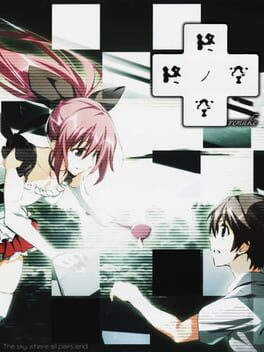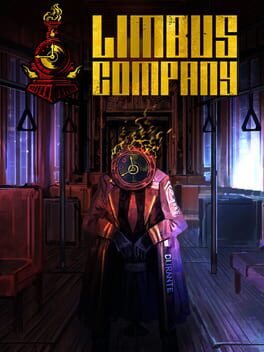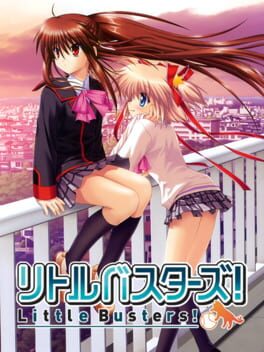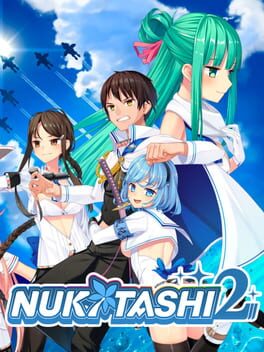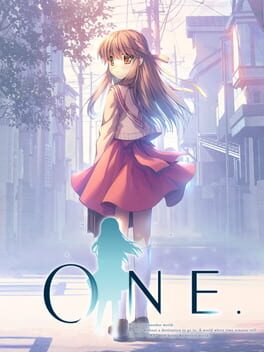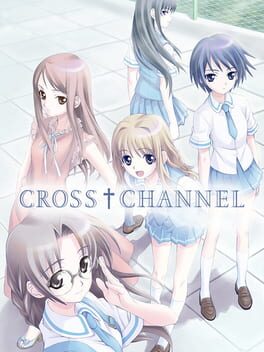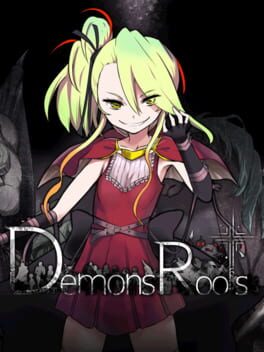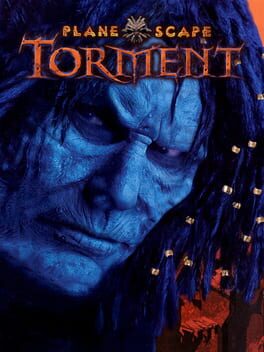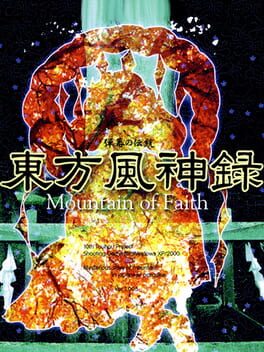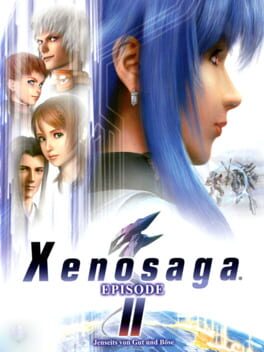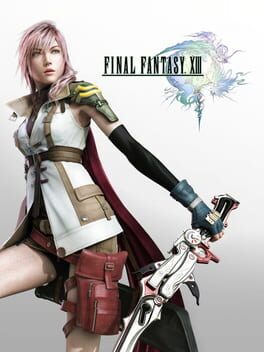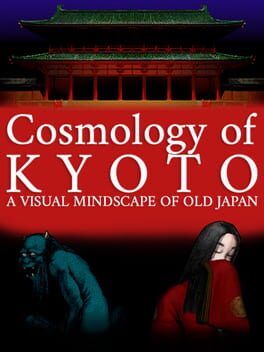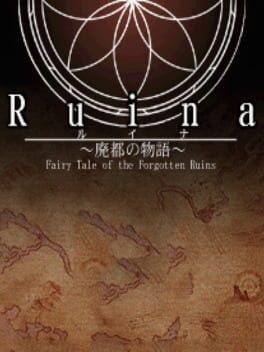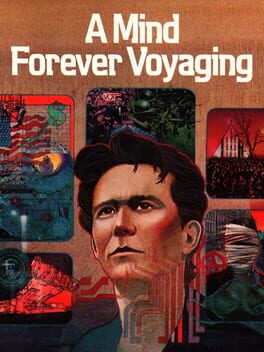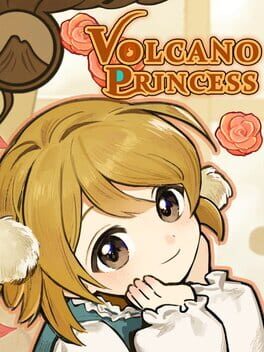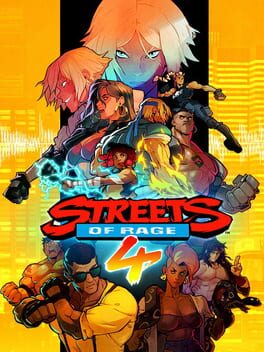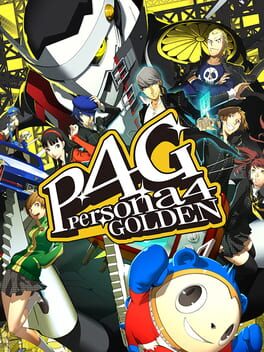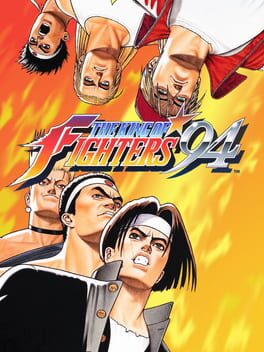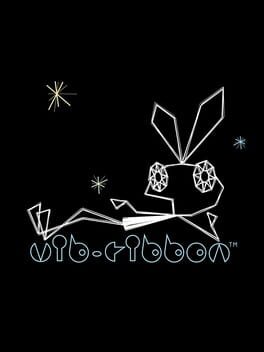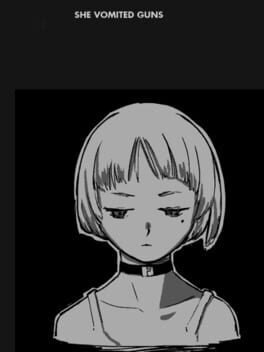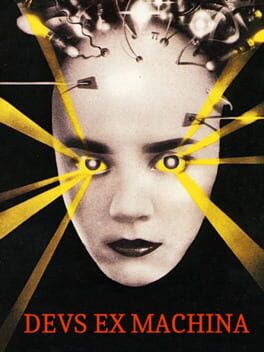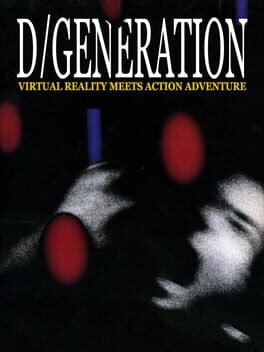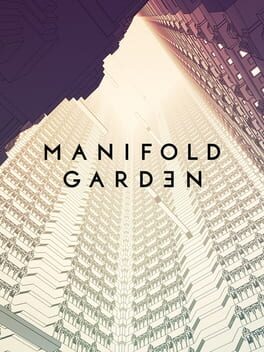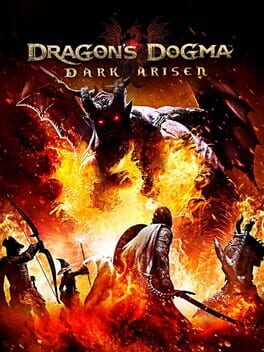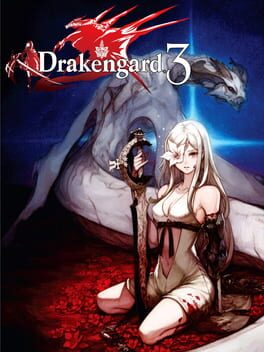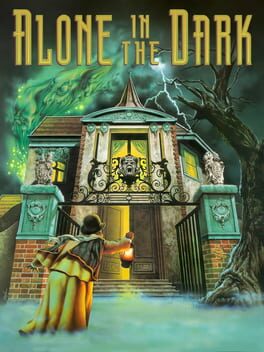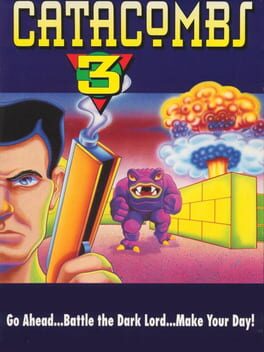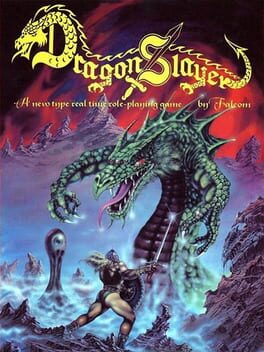Loroto
48 reviews liked by Loroto
Tsui no Sora Remake
2020
Considering I've already written over 7,000 words on the original Tsui no Sora on this site, I intend to keep things a little shorter for now. My intentions below are to both discuss some route-by-route feelings in comparison to the original game, as well as further ruminate on the philosophical and thematic elements of both Tsui no Sora and Subarashiki Hibi. I'll give a spoiler warning when we jump full-on into dangerously heavy spoiler territory below. Still, mild spoilers for all three games within.
I don't think you need to have played the original game to appreciate the remake, you certainly need Subahibi, though. The original is helpful for understanding some of the deliberate deviations the remake gets at, some of which are pretty major, but you could feasibly play this with just Subahibi under your belt and get 85% of the point. It's hard to image what sort of impression the remake would land if not taken as an addition to the previous iterations of this story. I think above all else, SCA-Ji was able to more directly address additional influences over the original Tsui no Sora in the remake. Not only did he buckle down and more directly address the most obvious influence, being Nietzsche and particularly Zarathustra, but the influences of Spinoza and Lovecraft are even more clearly dug into and elaborated upon here in ways that are rewarding if you've spent time thinking about Subahibi for as long as many of us have.
Presentation-wise, the remake is a very interesting hodgepodge of KeroMakura styles and talents. Motoyon and SCA-Ji both take lead artistic roles here, and while SCA-Ji very much still draws in the same style he has since around the H2O and Subahibi days, Motoyon was clearly already adjust his style for the upcoming Sakura no Toki and so it comes off much more modernized. Motoyon also did most of the CGs, which are absolutely beautiful. Rarely as abstract as some of Subahibi's, but beautiful nontheless.
This sort of disorientation is largely supplemented by the fact that many background elements are ripped right from Subahibi, and the soundtrack is pretty much all the original ~15 second loops from the original Tsui no Sora. ... Until this isn't the case from Fourth View onwards, where elements of Subahibi begin to melt in from the soundtrack to a few pieces of CGs. The voice cast is largely different, and the only people who reprise their roles from Subarashiki Hibi do so with intent. Largely great performances all around. Each of the ending themes is an instrumental remix of one of the Tsui no Sora tracks and they're all fantastic. I think my favorites were Third View and Numinöse II.
On a route by route basis -
First View was a bit different from the original, largely in how it characterizes Yukito. I really liked the more grounded and empathetic view of his character this time around, and I wouldn't say it "replaces" the original because they're largely coming from places with different intentions. Otherwise, note for note, extremely faithful to the original everywhere it should've been. Second View was definitely interesting. There were a few moments of characterization missing that I loved in the original, even if they were small beats, and at first I wasn't sure how I felt about it. But once the plot started ramping up and the big deviations from the original plotline kicked in, largely revolving around Yasuko's feelings towards Kotomi I ended up absolutely loving it. Despite some minor nitpicks in the first half it's absolutely a stronger version of this story line. I have little in the way of notes for Third Route. It's just a straight up improvement over the original in every way. Admittedly cried to the ending.
... And that's where things got really interesting.
Massive spoilers for the remake and Subarashiki Hibi below.
I had heard tell that Yasuko of all characters was the protagonist of a new route in the remake, but somehow I wasn't expecting it to be earlier in the game than Takuji. I also wasn't expecting it to be arguably the best part of the game. She's simply one of SCA-Ji's best characters I've yet to experience. A deeply morally conflicting character who scratches directly at the wound that plagues every iteration of this story - the incessant babbling about existentialism and purposelessness of life means nothing in the face of love. And Yasuko is a character who has had her humanity stripped from her by force - but still clings to the subconscious believe that love is worth fighting for. You can say she's really fucked up for how she tries to get with Kotomi and you're definitely right, but by the end of the route, when she and Kiyoshi just get to have that heart to heart... shit, man, that's the point of the whole story. That's what each version of this game has been trying to say since 1999. Even if SCA-Ji himself couldn't have put it into words yet.
Final View was certainly interesting. I really loved that some of the abstract visions from the original game were left intact, 1999 artwork against 2010 backgrounds and all. I also really enjoyed how much Takuji and Riruru were given time to expand upon their relationship to one another. One of the strongest elements of the remake's stab at this story is how much it points its cast in the direction of "reality of the heart". In the same way that Yasuko had to come to terms with her feelings for Kotomi, Takuji has to do the same for Yukito - the nature of those feelings may be vague, but I chose to interpret it as an attraction of the mind. Maybe there's some homo-eroticism in there and I wouldn't deny that, but I think it's more that Takuji sees a home and a place of understanding in Yukito. I'm... gonna have to sit with the moment he hears Kimika's voice and unbox why that was for a minute. It's the most confounding and jaw-dropping moment in the entire route and it's gone within a second. Again, there are a few minor things I do miss from the original, especially some of the more abstract denpa effects like Riruru's number spiral form or the eyeball bleeding into the pool, but this version of Final View has many aspects that undeniably surpass the original and at the very least do the series as a whole serious justice.
And then there's the Numinöse duology. Numinöse I seems largely unchanged from the original, but that's fine - I already like that ending more than most. Numinöse II has some interesting changes itself, and the duology as a whole stands as a rather interesting conclusion to the series overall. I'm happy that SCA-Ji keeps it vague and never actually explains what Ayana is. The Nyarlathotep explanation is an interesting proposition, the Cthulhu explanation is also interesting, and the way she molds and shifts around her necessities and whims, or those of others... all interesting. As far as where I stand on Ayana, and the purpose of the End Sky itself? Well...
First off, it was incredibly gratifying to get SCA-Ji backing me up on my original read of what the End Sky represents - it's the doorway to an Übermenschian evolution, the discarding of humanity and subjectivity to become, as Riruru and Ayana put it, a "third-dimensional existence". I think this is the purpose of Yasuko saying what she does on the rooftop to Takuji - to discard humanity is to discard our ability to love, because love is founded in perception and irrational thought. It's not so much that the End Sky exists, or that it doesn't - it appears in many ways to many people, as an escape, as an evolution, as an ending. Perhaps that's why Kimika's voice reaches Takuji in the end, as a reminder that he is human, and is capable of a love that transcends his own delusions. I've said it before, and I'll say it again - Down the Rabbit-Hole I and the "good endings" of Subahibi are the entire point. They're the response SCA-Ji makes to himself and his work in Tsui no Sora, and now he's returned to this early work and planted seeds of that answer into the bleak and hopeless place he left behind in 1999. I do believe the only presence that actually does sit above humanity in all of this is Ayana - who is more of an idea than a tangible thing. I think you can rationalize that existence many ways: a monster, a schoolgirl, a cosmic terror, a god, a magical girl - but ultimately, Ayana is objectivity. She is the third-dimensional existence that plays out stories and creates scenarios for the purpose of understanding humanity. And if it's not directly her doing - though clarity on that isn't really necessary - then she's merely observing. It's not that she's cold, it's not that she's cruel, feelings just don't process for her. It's all an imitation or an attempt to emulate expression. But that begs the question, which she asks Yasuko - what's the difference in attempting to understand and engage with human emotion and actually having those emotions, considering neither exist on the plane of logical thinking or rationality either way? Where does the line blur between emulation and experience? Fantasy and reality? Truth or feelings? An ending or a beginning? Takuji or Yukito? Ayana or Kotomi? The End Sky. The unreachable all-knowingness that we seek in spite of its non-existence. Human ambition. Yearning to understand. Indulgence in sophistry. The answer was already in front of us. Live happily in the wonderful everyday.
SCA-Ji is the fucking man. That's the be-all-end-all of this whole thing.
I don't think you need to have played the original game to appreciate the remake, you certainly need Subahibi, though. The original is helpful for understanding some of the deliberate deviations the remake gets at, some of which are pretty major, but you could feasibly play this with just Subahibi under your belt and get 85% of the point. It's hard to image what sort of impression the remake would land if not taken as an addition to the previous iterations of this story. I think above all else, SCA-Ji was able to more directly address additional influences over the original Tsui no Sora in the remake. Not only did he buckle down and more directly address the most obvious influence, being Nietzsche and particularly Zarathustra, but the influences of Spinoza and Lovecraft are even more clearly dug into and elaborated upon here in ways that are rewarding if you've spent time thinking about Subahibi for as long as many of us have.
Presentation-wise, the remake is a very interesting hodgepodge of KeroMakura styles and talents. Motoyon and SCA-Ji both take lead artistic roles here, and while SCA-Ji very much still draws in the same style he has since around the H2O and Subahibi days, Motoyon was clearly already adjust his style for the upcoming Sakura no Toki and so it comes off much more modernized. Motoyon also did most of the CGs, which are absolutely beautiful. Rarely as abstract as some of Subahibi's, but beautiful nontheless.
This sort of disorientation is largely supplemented by the fact that many background elements are ripped right from Subahibi, and the soundtrack is pretty much all the original ~15 second loops from the original Tsui no Sora. ... Until this isn't the case from Fourth View onwards, where elements of Subahibi begin to melt in from the soundtrack to a few pieces of CGs. The voice cast is largely different, and the only people who reprise their roles from Subarashiki Hibi do so with intent. Largely great performances all around. Each of the ending themes is an instrumental remix of one of the Tsui no Sora tracks and they're all fantastic. I think my favorites were Third View and Numinöse II.
On a route by route basis -
First View was a bit different from the original, largely in how it characterizes Yukito. I really liked the more grounded and empathetic view of his character this time around, and I wouldn't say it "replaces" the original because they're largely coming from places with different intentions. Otherwise, note for note, extremely faithful to the original everywhere it should've been. Second View was definitely interesting. There were a few moments of characterization missing that I loved in the original, even if they were small beats, and at first I wasn't sure how I felt about it. But once the plot started ramping up and the big deviations from the original plotline kicked in, largely revolving around Yasuko's feelings towards Kotomi I ended up absolutely loving it. Despite some minor nitpicks in the first half it's absolutely a stronger version of this story line. I have little in the way of notes for Third Route. It's just a straight up improvement over the original in every way. Admittedly cried to the ending.
... And that's where things got really interesting.
Massive spoilers for the remake and Subarashiki Hibi below.
I had heard tell that Yasuko of all characters was the protagonist of a new route in the remake, but somehow I wasn't expecting it to be earlier in the game than Takuji. I also wasn't expecting it to be arguably the best part of the game. She's simply one of SCA-Ji's best characters I've yet to experience. A deeply morally conflicting character who scratches directly at the wound that plagues every iteration of this story - the incessant babbling about existentialism and purposelessness of life means nothing in the face of love. And Yasuko is a character who has had her humanity stripped from her by force - but still clings to the subconscious believe that love is worth fighting for. You can say she's really fucked up for how she tries to get with Kotomi and you're definitely right, but by the end of the route, when she and Kiyoshi just get to have that heart to heart... shit, man, that's the point of the whole story. That's what each version of this game has been trying to say since 1999. Even if SCA-Ji himself couldn't have put it into words yet.
Final View was certainly interesting. I really loved that some of the abstract visions from the original game were left intact, 1999 artwork against 2010 backgrounds and all. I also really enjoyed how much Takuji and Riruru were given time to expand upon their relationship to one another. One of the strongest elements of the remake's stab at this story is how much it points its cast in the direction of "reality of the heart". In the same way that Yasuko had to come to terms with her feelings for Kotomi, Takuji has to do the same for Yukito - the nature of those feelings may be vague, but I chose to interpret it as an attraction of the mind. Maybe there's some homo-eroticism in there and I wouldn't deny that, but I think it's more that Takuji sees a home and a place of understanding in Yukito. I'm... gonna have to sit with the moment he hears Kimika's voice and unbox why that was for a minute. It's the most confounding and jaw-dropping moment in the entire route and it's gone within a second. Again, there are a few minor things I do miss from the original, especially some of the more abstract denpa effects like Riruru's number spiral form or the eyeball bleeding into the pool, but this version of Final View has many aspects that undeniably surpass the original and at the very least do the series as a whole serious justice.
And then there's the Numinöse duology. Numinöse I seems largely unchanged from the original, but that's fine - I already like that ending more than most. Numinöse II has some interesting changes itself, and the duology as a whole stands as a rather interesting conclusion to the series overall. I'm happy that SCA-Ji keeps it vague and never actually explains what Ayana is. The Nyarlathotep explanation is an interesting proposition, the Cthulhu explanation is also interesting, and the way she molds and shifts around her necessities and whims, or those of others... all interesting. As far as where I stand on Ayana, and the purpose of the End Sky itself? Well...
First off, it was incredibly gratifying to get SCA-Ji backing me up on my original read of what the End Sky represents - it's the doorway to an Übermenschian evolution, the discarding of humanity and subjectivity to become, as Riruru and Ayana put it, a "third-dimensional existence". I think this is the purpose of Yasuko saying what she does on the rooftop to Takuji - to discard humanity is to discard our ability to love, because love is founded in perception and irrational thought. It's not so much that the End Sky exists, or that it doesn't - it appears in many ways to many people, as an escape, as an evolution, as an ending. Perhaps that's why Kimika's voice reaches Takuji in the end, as a reminder that he is human, and is capable of a love that transcends his own delusions. I've said it before, and I'll say it again - Down the Rabbit-Hole I and the "good endings" of Subahibi are the entire point. They're the response SCA-Ji makes to himself and his work in Tsui no Sora, and now he's returned to this early work and planted seeds of that answer into the bleak and hopeless place he left behind in 1999. I do believe the only presence that actually does sit above humanity in all of this is Ayana - who is more of an idea than a tangible thing. I think you can rationalize that existence many ways: a monster, a schoolgirl, a cosmic terror, a god, a magical girl - but ultimately, Ayana is objectivity. She is the third-dimensional existence that plays out stories and creates scenarios for the purpose of understanding humanity. And if it's not directly her doing - though clarity on that isn't really necessary - then she's merely observing. It's not that she's cold, it's not that she's cruel, feelings just don't process for her. It's all an imitation or an attempt to emulate expression. But that begs the question, which she asks Yasuko - what's the difference in attempting to understand and engage with human emotion and actually having those emotions, considering neither exist on the plane of logical thinking or rationality either way? Where does the line blur between emulation and experience? Fantasy and reality? Truth or feelings? An ending or a beginning? Takuji or Yukito? Ayana or Kotomi? The End Sky. The unreachable all-knowingness that we seek in spite of its non-existence. Human ambition. Yearning to understand. Indulgence in sophistry. The answer was already in front of us. Live happily in the wonderful everyday.
SCA-Ji is the fucking man. That's the be-all-end-all of this whole thing.
Limbus Company
2023
(Canto VI)
Cannot be understated how Project Moon are the best developers in the game right now and nothing else is even close to what they've been able to do. This is what gacha SHOULD be for, long-form and with an immense variety of storytelling styles. From Canto 4's near-future sci-fi approach to Canto 5's nautical travel, and Canto 6's period piece drama, and the many side stories inbetween these. Sure, 4 and 5 had their issues despite their peaks being at the same tier as their previous works, but 6 FEELS like they've understood how this medium works, and they've used that to nail its pacing, its characters, its plot, continuing to advance so many overarching plot lines but also creating an amazing conclusion to Heathcliff, with such perfect attention to detail in its presentation and boss fights more in-tune with Ruina's... it really cannot be overstated how ahead of the curve PM is, how above in quality they are in everything, and how excited I am for what they continue to make in this long story that'll span many years.
Cannot be understated how Project Moon are the best developers in the game right now and nothing else is even close to what they've been able to do. This is what gacha SHOULD be for, long-form and with an immense variety of storytelling styles. From Canto 4's near-future sci-fi approach to Canto 5's nautical travel, and Canto 6's period piece drama, and the many side stories inbetween these. Sure, 4 and 5 had their issues despite their peaks being at the same tier as their previous works, but 6 FEELS like they've understood how this medium works, and they've used that to nail its pacing, its characters, its plot, continuing to advance so many overarching plot lines but also creating an amazing conclusion to Heathcliff, with such perfect attention to detail in its presentation and boss fights more in-tune with Ruina's... it really cannot be overstated how ahead of the curve PM is, how above in quality they are in everything, and how excited I am for what they continue to make in this long story that'll span many years.
Little Busters!
2007
Put this down as one I've got to sit with in order to give stronger, more detailed thoughts on. In the same way that revisiting CLANNAD was important as a piece of self-reflection and an analysis on my own growth and changes over the decade-plus since I'd first played it, Little Busters! served to embolden my understanding of how important my friend group has been every step of the way through those changes. One of the most tightly-organized Key games, with every route offering something to the grander narrative, and while After Story from CLANNAD remains the personal peak of their output for me, you'd be hard-pressed to find a true ending route with the sheer payoff and emotional conviction of Refrain elsewhere in the medium.
I'm going to take a break from finishing the Ecstasy routes, having completed Saya's, and go back for Kud Wafter in the same stretch of time. I'd like to let the original game sit a little longer, Refrain given time to wash over me a little more, and hell - maybe I'll even watch the anime, because I really do love this cast and their stories. The Little Busters are eternal, forever and ever.
I'm going to take a break from finishing the Ecstasy routes, having completed Saya's, and go back for Kud Wafter in the same stretch of time. I'd like to let the original game sit a little longer, Refrain given time to wash over me a little more, and hell - maybe I'll even watch the anime, because I really do love this cast and their stories. The Little Busters are eternal, forever and ever.
Tsui no Sora
TBD
Author’s note I — I am considering the possibility of opening a YouTube channel and using this script as the basis for a video on Tsui no Sora. If that becomes a reality, I intend to leave this original essay up as long as my Backloggd account is active. Should this interest you as a possibility, please feel free to let me know in the comments. This is my longest work on this site by far, and I sincerely appreciate anyone who reads any length of my work. Thank you so much.
Author’s note II — During the process of writing this piece on Tsui no Sora, which took me over a month of drafting, rewrites, and rearrangement, it has come to pass that mangaka and artist Akira Toriyama has passed away. You will see immediately that Toriyama-sensei’s work has had a profound impact on my art to this day within this very piece as Dragon Quest IV, my favorite video game that he was involved with, is a major talking point within this essay. I simply wish to express my grief and sorrow for the loss of such an incredible force of good and artistic passion in the world, and to thank him for contributing what he did to the greater tapestry of artistry during his active years. Thank you for everything, sensei, and may you rest in paradise.
Author's note III — Of course, a day after releasing this piece I come to notice some errors and additions I wish to make. Thanks to my friends in the small but tight-knit Tsui no Sora community in the West for their feedback and insight. Changes made within will be inserted seamlessly, so no worries to new readers about inaccuracies or loose ends.
==================================================
Die Geburt der Tragödie.
==================================================
Of course, in order to start talking about Tsui no Sora, I need to talk about a completely different game. Last month, one of my favorite role-playing games celebrated its thirty-fourth anniversary. Released for the Famicom on February 11, 1990, Enix’s Dragon Quest IV is deservedly considered one of the most influential and tide-turning games of the 8-bit era. While Dragon Quest III no doubt defined the shape of turn-based role-playing games to come, I would argue that the narrative influences that its sequel planted within not just its genre sphere, but the medium of video games as a whole, is equally as important.
For those unfamiliar with the structure of Dragon Quest IV, the game is told across five chapters, and each of the first four chapters follows the perspective of a different character inhabiting its world. Chapter One sees soldier Ragnar McRyan return abducted children to their parents by slaying a nearby monster, Chapter Three is an entirely removed story about the portly Torneko and his journey to become the world’s greatest merchant, so on and so forth. When the fifth and final chapter begins, the player is finally put in control of Solo, the protagonist featured on the game’s box art. While this chapter too starts off isolated as the others, an amazing development occurs partway through - each of the cast members the player followed in the preceding chapters resolves to join the hero’s party and with them their stories align, turning this fantasy anthology into a cohesively structured narrative, simply taken in across a handful of perspectives before culminating in the climax, in which the “main story” unfurls.
Now, I’m not going to claim that Dragon Quest IV is the first within the gaming medium to tell a story across multiple protagonists’ perspectives like it does - my knowledge of gaming history isn’t so strong - but it’s certainly one of the most important early adopters of the narrative device. Its influence can be felt all across the medium, both in role-playing games like LIVE A LIVE and MOTHER3 and beyond the genre’s confines. The idea of multiple protagonists experiencing their own stories in a revue-style suite of plot points before assimilating into the key narrative has, in the wake of Dragon Quest IV, become a well-trodden and beloved template with which to tell stories in video games… and that’s why I think it’s so interesting that a game like Tsui no Sora breaks that formula down and turns it on its head the way it does.
First, a little context.
Tsui no Sora, also known as Endsky, is the debut title by Japanese doujinsoft studio KeroQ. The entire story was written and directed by the enigmatic co-founder of the circle, SCA-Ji. To discuss any of SCA-Ji’s work properly necessitates two points of knowledge about the guy. The first is that he is incredibly well read - Tsui no Sora and his later work never shies away from directly referencing, analyzing, and arguably providing a narrative adaptation of high-octane writings on philosophy, psychology, mathematics, and meta-physics, as well as a plethora of international fictional literature ranging from children’s stories to thought-provoking and oft-debated works of literary high art. And we’re not talking simple name-drops - SCA-Ji clearly displays an academic understanding and digestion of the topics he chooses to reference in his writing, and one of his greatest gifts as an author lies in his ability to weave these stories, essays, theories and ideologies into his work - not by turning his characters into walking vessels for these concepts, but allowing the themes to embolden his characters, giving further depth to the lives they lead, the feelings they go through, and the ideals they arrive at and clutch onto. The second point of necessary understanding is, as fans and detractors alike will be happy to inform you, that SCA-Ji is unabashedly insane. I don’t mean in the same sort of quirky, “oh, you!” way that people look at Hideo Kojima or Kotaro Uchikoshi - the guy is a true looney. Following SCA-Ji on social media is a game of Russian roulette; sometimes, you get analytical posts about the things he’s reading, thinking about, and playing, sometimes he’s sharing fan art of his characters with huge dicks, sometimes he’s talking about how it’s perfectly normal to do the deed with raw chicken in Japanese supermarkets and vouching for the legitimacy of incest. He’s a gem, and I wouldn’t have the guy any other way. No, like seriously - I think the most compelling thing about SCA-Ji’s presence is the fact that even in the current era of the eroge landscape, he’s still acting like the same perverted weirdo he no doubt was when it was normal to be that type of person in the amateur scene around the time of Tsui no Sora’s release. No matter how one feels about SCA-Ji’s viewpoints and opinions, it’s undeniable that his work is endlessly earnest and entirely his. You can’t fake that, and plenty in the wake of his debut on the scene have tried and failed.
So, back to KeroQ themselves - if you’re looking for a more detailed look at their history, I can’t overlook this awesome video by BaseSk8er about their early days. Highly recommend this channel to anyone interested in eroge history in general, in fact. At the expense of lifting BaseSk8er’s work for my own, I’ll leave further influences on Tsui no Sora to largely be explained elsewhere. That said, it’s undeniable how strong of an influence both the fictional and academic literature SCA-Ji had been taking in at the time, as well as contemporary otaku artwork, particularly GAINAX’s Neon Genesis Evangelion, held on the story, themes, character designs, and imagery. One of the main characters, Takuji Mamiya, even has his design and some personal traits heavily lifted directly from Eva protagonist Shinji Ikari. However, if we’re going to talk about dominant influences and themes within Tsui no Sora, we need to discuss my favorite genre in Japanese media, one essentially dominated by eroge works in representation and although not necessarily birthed within eroge, it certainly found its home within the medium: the urban horror of denpa.
Denpa, which literally translates as “electromagnetic wave”, refers to either a narrative genre or character archetype revolving around those on the fringe of society. Denpa characters operate on a different wavelength than “normal” society; delusional street-wanderers who find fear, paranoia, and a loosening grip on “objective reality”, often finding themselves wrapped up in urban legends, conspiracies, and the modern occult. These stories tend to also revolve around themes of trauma, lack of a sense of self, and spiraling into insanity. Arguably the first truly denpa work within video games was Leaf’s 1996 debut eroge Shizuku, which is where the term “visual novel”, the name of the trilogy that Shizuku started, was adopted from when describing ADV games and eroge in the West. While Shizuku certainly has a reputation of being the grandfather of denpa eroge, generally there are three names brought up as the “holy trinity” of the genre in terms of cultural impact, innovation, and influence on eroge to come. Tsui no Sora was the first release to be considered part of this trinity, followed in 2001 by Duke’s Jisatsu no Tame no 101 no Hoho and CRAFTWORK’s iconic Sayonara o Oshiete. Plenty of the most iconic eroge and ADV titles ever made, whether or not they’re entirely denpa works or not, owe a great deal to the influence of these titles and the denpa genre as a whole - just to list off some names, you wouldn’t have Saya no Uta, Tsukihime, Fate/stay night, Higurashi no Naku Koro ni, the Science;Adventure series, or Kimi to Kanojo to Kanojo no Koi. without these games.
But, if there’s one title that clearly defines all that denpa is as a grounds for storytelling and has reached unprecedented acclaim on an international level, it’s the legendary 2010 title Subarashiki Hibi ~Furenzoku Sonzai~, a game that shares a rather… enigmatic and bizarre relationship with Tsui no Sora. Initially, there were plans within KeroQ dating back to the early 2000s to remake Tsui no Sora in a modern engine - likely after the completion of the next major work SCA-Ji had on his mind, Sakura no Uta (which, ironically, would not see proper completion until 2015). During this nebulous talk of a Tsui no Sora remake, ideas for two other titles were brewing in SCA-Ji’s mind, “Subarashiki Hibi” and “Diskontinuierliches Dasein”. Eventually, these two titles likely worked their way into this initial Tsui no Sora remake attempt, blossoming into a strange re-imagining and interpretation of the original game - the Subahibi we would receive in 2010 - in a fashion not unlike Jonze/Kaufman’s Adaptation. in relation to its source material, The Orchid Thief. I, like many other fans of KeroQ’s output, first found them through Subahibi, and so my basis for the cast, story, and themes of Tsui no Sora comes first and foremost through their 2010 reimagined selves. Tsui no Sora is largely retold through three of Subahibi’s chapters, “Down the Rabbit-Hole II”, “It’s My Own Invention”, and “Looking-Glass Insects”. Without diving into spoilers for an entirely different game, it’s hard not to be absolutely curious about what the original Tsui no Sora is like once the final lines of Subahibi come and go. For the 10th anniversary of Subarashiki Hibi, KeroQ would release a limited edition box-set, including not only the original 1999 Tsui no Sora, but a new Tsui no Sora remake proper - intended to be read after Subarashiki Hibi, which I have yet to do. With two reworks of varying loyalty to the source material with over twenty years of hindsight, it would be an understandable assumption that the original Tsui no Sora now serves largely as a historical footnote, a blueprint for two works with decades of polish and hindsight from which to usurp its long-held title. With that said, I disagree. Not only do I feel that Tsui no Sora and Subarashiki Hibi inform readings and interpretations of one another greatly, but I absolutely loved my time with this classic of the eroge scene and found it compelling entirely on its own merits, some of which are completely different in approach and execution than its legendary successor.
I think with a little over 1,700 words under our belts in this piece on KeroQ’s 1999 debut work, Tsui no Sora, I can now begin talking about KeroQ’s 1999 debut work, Tsui no Sora.
==================================================
Through the looking-glass.
==================================================
The focal point of the entire plot of Tsui no Sora essentially revolves around two major events: the sudden suicide of loner Zakuro Takashima, and the subsequent rise and fall of a death cult convinced of the oncoming apocalypse on July 20, 1999, under the leadership of the once meek self-assessed teenage messiah, Takuji Mamiya. One could frame the entire plot of the game under these terms, stating that these events are more or less the entirety of “what happens” in Tsui no Sora. However, what makes this interesting is the fact that we examine the roughly two week period in which these two events take place under four different lenses. Rather than the Dragon Quest IV approach of telling a revue of separate short stories, Tsui no Sora essentially tells fragments of the same story four times with the narrative perspective of four very different students of the school where most of the story occurs. The first chapter or “First View” is told through the well-read but ambivalent eyes of Yukito Minakami, “Second View” follows his childhood friend and patented genki girl Kotomi Wakatsuki, “Third View” revolves around the days leading up to the death of Zakuro Takashima in her own account, and “Fourth View” finally lands on the denpa wonderland and ascent to urban godhood of Takuji Mamiya. It is established early on that Yukito and Takuji essentially sit on opposite sides of the same philosophical scale, but it should be noted that much of the pathos and emotional tug of Tsui no Sora is found in the girls’ stories, which are both arguably the most gut-wrenching and painful stories within. I believe it’s best that we take this chapter by chapter, to properly assess the viewpoints and thematic purpose of each protagonist’s story.
"First View"
To anyone who’s played Subarashiki Hibi, Yukito’s story should feel right at home. A large amount of the story would be lifted as the basis for “Down the Rabbit-Hole II”, but there are certainly still differences between the two. Being that Yukito is a young man, his manzai-like banter with Kotomi should feel right at home with many ecchi works of the era. If he weren’t so well-read, it would be easy to pass Yukito off as your typical stand-in ecchi protagonist - but it’s in his more intimate moments of reflection, as well as his rooftop conversations over bento with the denpa epicenter of Tsui no Sora’s cast, Ayana Otanashi, where his depth is made clear. Spending his remaining high-school days with intent laziness, most of Yukito’s deeper thoughts revolve around the “big questions”, considering the writings of Kant and Wittgenstein as he begins to form his own philosophies about the world and humanity. To me, Yukito reads like he has a lot of faith in humanity, but not a lot of faith in people. He’ll postulate over the crocodile tears and lack of genuine interest his classmates take in the wake of Zakuro’s death, claiming that none of them (himself included) have any right to grieve a girl they so clearly ignored. Yet, he’ll also go on internal tangents about that spark within humanity that simply cannot be explained through logic: our issues with God, our emotional dilemmas, and the purpose we find in being around other people.
The irony in this dichotomy is that Yukito ends up being the character that perhaps spends the least time considering others as well as their own place within the world, despite all of this internal hem-haw; again, Yukito and Takuji stand on opposite sides of a spectrum, and that’s also clear in how much initiative is taken in their actions through the lead-up to the 20th. I’ll talk about Takuji later, but really it’s funny that for a “protagonist” if there is one proper in Tsui no Sora, Yukito doesn’t really do so much as he considers, with the exception of the final act of his route in which he rescues Kotomi from the clutches of Takuji’s cult. I find Yukito compelling as a lead because he’s simply enjoyable to witness talking to others, thinking about the world, and ultimately find his conviction when dropping the philosophical pretenses and acting out of pure care for Kotomi when push comes to shove. I wouldn’t go as far to say that he “grows” over the course of his route, really, but he does show a softer side in the back half that contradicts his initial aloof coolness. He might be the member of the Tsui no Sora leading crew that ponders the big questions the most, but he’s also arguably its most put together and adjusted member.
"Second View"
While Kotomi Wakatsuki's route certainly informed the development of cast members and plot beats within Subahibi’s “Down the Rabbit-Hole” duology, I’m happy to say that this story is one that remained a virginal and surprisingly fresh perspective for someone who first experienced that later rendition of this story. While the more identifiable aspects of Kotomi’s character were split into Subahibi’s Wakatsuki twins (along with some blatant borrowing from CLANNAD’s Fujibayashi sisters, who both SCA-Ji and myself love dearly) she is a character that remains, in her original state, unique to Tsui no Sora. As the captain of the kendo team, Kotomi is a valued member of the social structure of the school, generally liked by her underclassmen, and unafraid to speak her mind and challenge others to put their money where their mouth is when the time comes. As I said when discussing Yukito’s route, the banter those two share is genuinely charming - but perhaps more interestingly, their lifelong friendship is also an area where Kotomi struggles internally. The future is approaching her faster and faster each day, and as things progress through her route, she gets real with herself and accepts that a time in her life in which Yukito isn’t close by, or in the arms of another, is one that would absolutely crush her. These are feelings understandable of any teenager dealing with a serious crush, but no doubt the death of Zakuro Takashima sends Kotomi’s insecurities and inability to get open, to get over the idea that she would be burdening Yukito with her vulnerability, down a dangerous and self-destructive path. The first time that Tsui no Sora resonated with me on a deep level was Kotomi’s initial response to the news of her death. SCA-Ji weaponizes sentence structure wonderfully in this section, with Kotomi initially sputtering off into internal tangents, recollecting her final meeting with the late Zakuro, trying to pick up the pieces and recall why she had thanked her for being so kind to her despite the two sharing a surface-level relationship at best, before she breaks down into repetitions of Zakuro’s name, apologies, and unfinished starts to trying to offer up some sort of explanation or amends to the deceased.
It wouldn’t be fair to call Kotomi’s route headier and more contemplative than Yukito’s per se, but the way it plays out feels much more reliant on her thoughts leading her actions and responses than his more philosophical ponderings. Kotomi continues to be plagued by two trains of thought through the majority of her route - the first, a direct guilt for what she believes in her fault in the ultimately death of Zakuro, which she hopes to manifest as some sort of emulation of the late girl’s pain, reaching out beyond the grave to try to understand what she was going through to lead her to the place she ended her life. This feels like projection of her own insecurities about the future, because the other main plot thread in her story revolves around her inability to express her desire to be with Yukito, or really even understand what her feelings towards him are. She understands him to be strong and unwavering, and also wishes to emulate that about him as well. On a larger scale, I think Kotomi is looking to better understand her place in the world, more specifically, where she belongs. This is a theme I believe to be consistent with the third and fourth routes of the game as well, and I’ll be looping back to this point later.
By the time that these plot points settled in, I began to realize just how good Tsui no Sora is at creating an alien and off putting atmosphere. I’m a big fan of the sketchy and clearly doujin art here, with a very vibrant and saturated color scheme that feels distinct from the lighter and more polished colors and linework of Subarashiki Hibi’s take on this cast and setting. Backgrounds are largely empty which works to great effect when alienating the cast members from the extra characters - it certainly feels like the spirited characters are almost the only “real people” in the world at each respective time. I would liken the soundtrack to that of the original Tsukihime, very brief, minimalist passages lasting around ten to thirty seconds on average, looping ad nauseam to wash over the player in a trance-like presence. There is no voice acting and hardly any sound effects to speak of, so most of your time is spent on either the sprites, the text, or the music - and it all blends together to birth a product that feels just off-center, just amateur enough to have a real sense of tension come crawling on the regular. We’ve yet to see Tsui no Sora firing on all cylinders in this department, but again, more on that later.
Whether or not Kotomi comes to the answers of these plaguing questions is left vague. Ironically, the torture she ends up enduring once the class turns towards Takuji - and thus against her and Yukito - is not unlike the pain and suffering Zakuro went through on a daily basis. Of course, even as she’s reminding herself to be strong like Yukito, considering Zakuro’s situation, she couldn’t know that they shared so much experience when she goes through it. She’s probably left wondering if she’s somehow done enough to atone for something that was never her fault to begin with. Of course, as we see in “First View”, Yukito does end up coming for her - but this is another place where Tsui no Sora plays with perspective so meaningfully. In fact, so much of Kotomi’s route plays with perspective directly in argument with Yukito’s. When he went off at her and Kimika in his route for even discussing Zakuro’s death, mumbling to himself about how none of them had any right to grieve her, we understand in Kotomi’s route that this moment absolutely broke her spirit and she already internalized the feeling that because she didn’t save her, because she felt she didn’t do enough, that she specifically had no right to grieve her death. Yukito does not understand the lengths which Takuji goes to try to win him over, including the fact that Kotomi doesn’t make it out of her kidnapping unscathed, having been subjected to physical and sexual torture in abundance. Yukito has no understanding of the personal betrayal Kotomi goes through in this process, having been sold over to Takuji by her close friend and underclassman Yasuko out of what are likely unrequited feelings of love soured in part by delusion into hate and jealousy. Of course Yukito saves her, but is it really a happy ending for Kotomi? Is what he does for her too little too late? Can she learn to heal from this experience? Thankfully, these things are left up to interpretation - because again, Kotomi is just one of the viewpoints of this story. And if she’s so concerned with emulating the pain of someone she knew so little about in passing, it only makes sense that the experiences of Zakuro Takashima herself come under discretion next.
"Third View"
While the perspective of Zakuro Takashima offers the vague plot points and themes that would go on to serve as the basis of Subarashiki Hibi’s “Looking-Glass Insects”, the intent of each of these renditions is different enough - and the execution so largely different - that it’s fair to think of “Insects” as a heavy, heavy revision and reinterpretation rather than a direct adaptation of “Third View”. Perhaps the most crucial change made in how “Insects” tells this story is the complete rework of background character Kimika Ishihara (renamed Kimika Tachibana in Subahibi) into a major player in several of the game’s chapters. In “Insects”, Zakuro has a home base in Kimika most of the time. She has someone to confide in even in spite of how many awful things she’s put through. There are people in her cruel and unfair world that still see her. In Tsui no Sora, this really isn’t the case for most of her chapter. The only person in the world that seems to regularly acknowledge her existence is Ozawa, her sexual abuser to whom she is essentially bound through no fault of her own. There is no build-up to how Zakuro truly feels about the world in Tsui no Sora, because there doesn’t have to be - there is an immediate, obvious understanding that the world Zakuro inhabits offers her nothing but anger, pain, and fear. There is simply no hope in her life, there is nowhere she belongs and nothing she believes in. There isn’t a Kimika in her life, and so every day is spent with the inconsolable fear of the next. Her life is hell, and a hell with seemingly no way out.
I spoke previously about Kotomi’s unique perspective and the theme of belonging that ran throughout her chapter. As I began to notice this theme seep into Zakuro’s route in its second act, in which she comes into contact with Usami and Ayumi, two girls who claim to have known her in a previous life as the magical soldier Angel Advise in their battle against an awful cataclysm, I truly began to appreciate the seeds that were being planted that Subarashiki Hibi would capitalize on down the line. One could argue, and they wouldn’t necessarily be wrong, that the path that Zakuro takes in the back half of “Third View” is ultimately one of destruction - taking her own life and ultimately those of these newfound friends in the process. But, at the same time, the Zakuro presented in Tsui no Sora is far more outwardly hopeless and spiteful prior to meeting them. Something I feel that Tsui no Sora arguably offers with an even more potent emotional affect is just how much Zakuro’s life is changed by making her first friends, and as a result having a place where she feels understood and, again, that she belongs to. This may be a result of the fact that Usami and Ayumi simply play a larger part in the Zakuro story than their Subahibi equivalents do, but I found the sisterhood shared between the three even more intense and heartfelt in the original rendition of this story. When Zakuro begins to take a leadership position and treads over the second-guessing of her fellow former “Angels”, the two thoughts that come to mind are of the catharsis that Zakuro must feel in having some level of control and agency for the first time in her life, and the conviction with which she clings on, desperately, to having a purpose and a place she understands that she is needed. Subarashiki Hibi expands on this world and its characters on an ultimately greater and more intricate level, I agree, but I think the Zakuro storyline sits at the very heart of the original Tsui no Sora and as a result is given even greater chance to shine as the emotional “purpose” of the story. More than anything, Tsui no Sora is a story that belongs to Takashima Zakuro - a dramatic irony lies in the fact that it takes her death for that to become apparent.
"Fourth View"
Sitting deep in the heart of Tsui no Sora is the final major chapter, the longest and most infamous of the perspectives. “Fourth View” is perhaps what Tsui no Sora is best known for - its most influential section, which puts the player behind the eyes of Takuji Mamiya - and so the grand denpa carnival begins. Previous chapters have seen Takuji as less of a proper character and more of an abstract force of chaos. The two modes we’ve seen him in - the sheepish, flitting coward, and the terrible, commanding preacher of the apocalypse - are so radically different from each other that it innately begs the question: what drove Takuji from Point A to Point B? While previous perspectives had brief stints with denpa, it’s no doubt the lunacy and almost eldritch horror of Takuji Mamiya’s perspective that not only influenced its Subarashiki Hibi equivalent episode, “It’s My Own Invention”, but also serves as the mark it most strongly made on the entire eroge scene in its wake. And what a ride it is.
It’s in “Fourth View” that the player gains an understanding of who Takuji is as a person - and in reality, he’s not all that different from Yukito in a few areas. He’s clearly bright, clearly passionate, but where Yukito stifles that with his own projected disinterest and apathy, Takuji’s flame is put out due to the harassment and abuse of his peers. For all the brilliance that clearly lies dormant in Takuji, his life has essentially been stripped of that glow to the chagrin of his predators - he is bullied, put into financial corners, and laid bare of all that makes him an individual. Based on the previous chapters, one might assume that Yukito is the strongest emotional presence in Takuji’s life, the attack on Kotomi something of a personal gambit done for the sake of provoking him into confrontation. “Fourth View” brings this idea into question, however, because it’s here we learn that the entire plot seems to be spurred on by the death of Zakuro Takashima.
Suddenly, these two plot points become connected on a level beyond Takuji simply using her death as additional reasoning in his proclamations of the end times. He grieves for Zakuro. He never concerns himself with whether or not it’s right for him or others to do so, her death has a profound effect on his outlook. Like Kotomi, he sees the purity in her presence and feels the weight of her loss on a personal level, regardless of how well he knew her, and it’s at this point where I started to consider the possibility that, under better circumstances, maybe the three living leads of Tsui no Sora could have been friends in a better, more communicative world. The audience comes to understand the bullied, battered-down life that Takuji leads of course, but it’s arguably through the death of Zakuro that he comes to accept life as unfair and broken on the level he does, which spurs his descent into madness and awakens a deep belief within that he is the Messiah of the world, advised by his beloved Magical Girl Riruru, leading a conquest within his school into the titular Endsky, accepting the death and rebirth of the world into absolute nil.
And what a descent into madness it is - it’s here where the game holds no more punches and we get to see KeroQ working their magic in creating some of the most unnerving, creative, and grotesque imagery in this era of the eroge scene. Real-life faces are warped and mutilated into eldritch horrors, the Magical Girl Riruru babbles on and on, crossing from spoken words into quadratic formulas and back again, bullies are revived from the dead with their fatal injuries still well intact, and KeroQ saves an exponential amount of cash by not hiring a seiyuu to accompany Takuji screaming bloody murder through the better half of this. It’s an absolutely glorious roller coaster ride into surrealism and the decay of someone whose conviction lies in the absolute dedication to nothingness that Takuji finds. If all Takuji ever wanted was a place to belong, he finds it here, a self-proclaimed Christ figure among the rabble of serfs who heed his every word. No teacher, no classmate, no sibling is safe from the depravity - and in all its hedonistic glory Takuji finds himself ironically more alienated from the people who would serve his word than ever before. He wants nothingness, and as they jump from the rooftop one by one, it’s fair to say he finds it.
… This is one conclusion to draw, of course.
==================================================
Beobachtungen über das Gefühl des Schönen und Erhabenen.
==================================================
The following section will feature spoilers for both the original Tsui no Sora and Subarashiki Hibi, in their entirety. Please be advised before moving forward.
There is a single conversation in the original Tsui no Sora that I feel stands as the strongest case for reading it as a companion piece to Subarashiki Hibi. I have not read the remake as of writing this essay, so I am not sure if this is retained there, so I don’t want to call this section “forgotten” - just the opposite. The final conversation in “Fourth View” between Takuji and Yukito on the rooftop plants a seed that SCA-Ji would only allow to blossom eleven years later, and it’s the moment of the game that has stuck with me the hardest in reflection.
In direct reference to a story from the Rigveda, Takuji offers a monologue to the dumbfounded Yukito about two eagles resting within the same tree. To summarize the purpose and the quandary presented within this conversation, Takuji likens himself to the second eagle, who watches the first eagle roost, enjoying his harvest and leading his nest. The second eagle only watches on as a lone observer on the tree, occupying the same space, but never actually enjoying what life has to offer. As Takuji leaps from the roof, admitting his admiration and adoration for Yukito, the empty sky hangs above, and I’m left wondering… was his assessment of which boy represents each eagle correct?
The onlooking eagle - a figure standing watch, never reaching out and simply existing unchanged and unmotivated to branch out and change no matter how much the victorious eagle harvests. Such uncertainty and lack of action doesn’t really represent Takuji Mamiya within Tsui no Sora to me. In fact, if there’s any character we’ve seen take the most action, engage with the most truly life-changing, exciting, and dynamic-shifting experiences in this game… it’s got to be him. From pushed around coward to the commanding shepherd of a flock of sycophants, ordering lives to be sullied, stripped, and cast away in the holy name of the Endsky. It’s a life cut off early but one lived ultimately with conviction, intent, and execution.
In one of the epilogue sequences, we follow the ascertained dominant eagle, Yukito, into a surreal and desolate version of his school. All that waits for him there is Ayana Otanashi - a character I’ve chosen to talk so little about to this point with intent - and all the time he could ever wish for. In this reality, which the two deem is likely some form of mirror image of the one they’ve known, the quiet is only broken by meaningless and copious sexual gratification and a plastic happiness with which to wait out limitless time. Interestingly, this idea of infinite space and time is a concept that Ayana has run by other members of the cast before, namely Takuji, as a hypothetical. Adding more and more “things” to an endless existence simply means more time for those things to sour, and while at first the erotic scenes with Ayana here mark some of the most “happy” and “feel-good” instances in an otherwise bleak and explicitly violent story, I couldn’t help but think back on these conversations. In a sense, it was almost as if Ayana was presenting this life without change to Yukito, the most stubborn and unchanging member of the cast. His inaction and disinterest granted him a quiet life without change, but without much else to hold onto beyond that. Is that reality so unlike the abyssal world which Takuji claimed he and his disciples would leave behind? Is his mulish demeanor and emotional blockage really the coveted have-all life Takuji likened to the victorious eagle in his parable?
Which “viewer” sought change the hardest, who pushed the hardest to find the place they belonged, and who was the happiest for it? Who got it right? In my opinion, this lingering question, above all else, not only explains the purpose for Subarashiki Hibi’s very existence, but also leads to a discussion of my own theory regarding its final chapter, the fittingly titled "Tsui no Sora II". There are many popular “lore”-based theories regarding this chapter, and to be perfectly clear I think the entire point of the ending is to be open to any and all interpretation, so please don’t think that I’m inserting my opinion as any more correct than anyone else’s. With that in mind, one of the other most important themes in both games is the layering of multiple perspectives over the same set of events or ideas in order to gain a more nuanced understanding of a multifaceted “truth”, and I do believe you’re missing a substantial piece of the puzzle without having played Tsui no Sora yourself.
Arguably the most important and famous line in Subarashiki Hibi is, of course, “live happily!”, a quote that gains prominence during the “Jabberwocky” chapter duology late into the game. The purpose of the title of the game itself, translating to “Wonderful Everyday”, is just that - the ability that anyone and everyone has to find tranquility, peace, belonging and above all else happiness in the mundanity of everyday life. Tsui no Sora provides the basis for the events - again, this story largely revolves around the death of Zakuro Takashima and the subsequent spiral into despair and proclaimed holiness of Takuji Mamiya. It is a world of little hope, little light and little answer to the above questions. How fitting, then, that Subahibi immediately adds its own layer to the perspectives - its opening chapter, “Down the Rabbit-Hole I”, ends up giving the answers to new readers well before they know the question. It marks the change in philosophy SCA-Ji went through as a philosophical mind and as a storyteller in the decade separating these two major iterations of the story. The paths of “Rabbit-Hole I” may lead protagonist Yuki to one of three possible endings - two of which, a hasty, needy rendezvous with either Kagami or Tsukasa, dropping the pretenses and hesitancy towards same-sex relationships masked as childhood friendship, embracing the reality of their feelings, allowing the wonderful everyday to take hold. Should the player choose to fall for the very well alive, very well expressive and happy Zakuro Takashima, though, the wonderful everyday comes from both the heartfelt expressions of blossoming love… and the tenderness with which Zakuro is able to express her thanks in an interpolation of Night of the Galactic Railroad, and join the infinite cosmos in much-deserved finality, peace, and rest. This level of hope, radiance, joy, recklessness, and adoration of love in spite of, living in spite of, daring to dream and to go out and do in spite of, it all permeates the dark world Tsui no Sora set the foundation for, the foundation which asked the question: “who really lived a fulfilling life of happiness?” And no matter the circumstances, no matter the context, this is the importance of the stories as retold through the lens of Subarashiki Hibi - the answer: “all of us”.
In “Tsui no Sora II”, we are led to believe that all of the events of the preceding game are the inventions or stitched-together memories and personalities which combine into the girl known as Ayana Otanashi - dismembering her full conscious into characters, settings, and reruns familiar to Tsui no Sora prior but with this newfound philosophy and conclusory response applied. This is also true of the second epilogue in Tsui no Sora, in which the line is blurred for Yukito between Kotomi and Ayana, perpetually floating in a sea of ambiguity and infinite time. In reference to this reoccurring theme as it appears in Subarashiki Hibi, though — what is the purpose of this? Why is she suddenly called back by a random student who prior to her appearance in the last minute of the game must have had a dozen lines maximum in the script? Why place this secret at the end of the rabbit-hole to begin with?
Ayana’s discussion of perspective and theorizing about the “reality” of Subarashiki Hibi with the game’s central protagonist, Yuki, rings the same bell that Takuji and Yukito’s conversation did at the end of Tsui no Sora. In our eyes as readers, Ayana may hold all the cards and the specific knowledge about the state of all things that we, proxy Yuki, lack… but all the same, what difference does that really make? SCA-Ji debunks his own former conclusion here. It could very well be that Tsui no Sora serves only as a blueprint to its far more beloved and discussed reimagining, it could be that theories of Ayana comatose in a hospital in the “Rabbit-Hole I” ghost house concocting dreams of sunflower fields hold some truth, it could be that the Tsui no Sora remake which I’ve yet to play will layer yet another perspective atop this forgery I lay before you now, adding context I couldn’t imagine and could very well shift my perspective on this game entirely. That’s the secret of the Endsky - the Tsui no Sora. Endsky is the collective, it is all conscious understanding and expression. The more people who read, believe these characters, and find themselves thinking about the “big questions”... the more we discuss this work, the more we overlay our perspective atop each others’, the greater the tapestry of understanding we create, indeed, the closer we climb up the endless ladder to the Endsky. If we just keep thinking, maybe we could reach the “truth” at the end of the rabbit-hole…
But, at the end of the day, just like that final scene in Subahibi shows the ever-present Ayana, we’ve all got class to go to and a life to live in. The game closes, the tab gets X’d out, and the discussion threads need to be put on pause eventually. Thinking and expressing the internal is wonderful and expression is how we come to define our world and existence to each other, but we have everyday life to attend to, after over 7,000 words together. Live happily, and seek your wonderful everyday a thought, a dream, a conversation, a laugh, a cry, and a wish at a time.
Author’s note II — During the process of writing this piece on Tsui no Sora, which took me over a month of drafting, rewrites, and rearrangement, it has come to pass that mangaka and artist Akira Toriyama has passed away. You will see immediately that Toriyama-sensei’s work has had a profound impact on my art to this day within this very piece as Dragon Quest IV, my favorite video game that he was involved with, is a major talking point within this essay. I simply wish to express my grief and sorrow for the loss of such an incredible force of good and artistic passion in the world, and to thank him for contributing what he did to the greater tapestry of artistry during his active years. Thank you for everything, sensei, and may you rest in paradise.
Author's note III — Of course, a day after releasing this piece I come to notice some errors and additions I wish to make. Thanks to my friends in the small but tight-knit Tsui no Sora community in the West for their feedback and insight. Changes made within will be inserted seamlessly, so no worries to new readers about inaccuracies or loose ends.
==================================================
Die Geburt der Tragödie.
==================================================
Of course, in order to start talking about Tsui no Sora, I need to talk about a completely different game. Last month, one of my favorite role-playing games celebrated its thirty-fourth anniversary. Released for the Famicom on February 11, 1990, Enix’s Dragon Quest IV is deservedly considered one of the most influential and tide-turning games of the 8-bit era. While Dragon Quest III no doubt defined the shape of turn-based role-playing games to come, I would argue that the narrative influences that its sequel planted within not just its genre sphere, but the medium of video games as a whole, is equally as important.
For those unfamiliar with the structure of Dragon Quest IV, the game is told across five chapters, and each of the first four chapters follows the perspective of a different character inhabiting its world. Chapter One sees soldier Ragnar McRyan return abducted children to their parents by slaying a nearby monster, Chapter Three is an entirely removed story about the portly Torneko and his journey to become the world’s greatest merchant, so on and so forth. When the fifth and final chapter begins, the player is finally put in control of Solo, the protagonist featured on the game’s box art. While this chapter too starts off isolated as the others, an amazing development occurs partway through - each of the cast members the player followed in the preceding chapters resolves to join the hero’s party and with them their stories align, turning this fantasy anthology into a cohesively structured narrative, simply taken in across a handful of perspectives before culminating in the climax, in which the “main story” unfurls.
Now, I’m not going to claim that Dragon Quest IV is the first within the gaming medium to tell a story across multiple protagonists’ perspectives like it does - my knowledge of gaming history isn’t so strong - but it’s certainly one of the most important early adopters of the narrative device. Its influence can be felt all across the medium, both in role-playing games like LIVE A LIVE and MOTHER3 and beyond the genre’s confines. The idea of multiple protagonists experiencing their own stories in a revue-style suite of plot points before assimilating into the key narrative has, in the wake of Dragon Quest IV, become a well-trodden and beloved template with which to tell stories in video games… and that’s why I think it’s so interesting that a game like Tsui no Sora breaks that formula down and turns it on its head the way it does.
First, a little context.
Tsui no Sora, also known as Endsky, is the debut title by Japanese doujinsoft studio KeroQ. The entire story was written and directed by the enigmatic co-founder of the circle, SCA-Ji. To discuss any of SCA-Ji’s work properly necessitates two points of knowledge about the guy. The first is that he is incredibly well read - Tsui no Sora and his later work never shies away from directly referencing, analyzing, and arguably providing a narrative adaptation of high-octane writings on philosophy, psychology, mathematics, and meta-physics, as well as a plethora of international fictional literature ranging from children’s stories to thought-provoking and oft-debated works of literary high art. And we’re not talking simple name-drops - SCA-Ji clearly displays an academic understanding and digestion of the topics he chooses to reference in his writing, and one of his greatest gifts as an author lies in his ability to weave these stories, essays, theories and ideologies into his work - not by turning his characters into walking vessels for these concepts, but allowing the themes to embolden his characters, giving further depth to the lives they lead, the feelings they go through, and the ideals they arrive at and clutch onto. The second point of necessary understanding is, as fans and detractors alike will be happy to inform you, that SCA-Ji is unabashedly insane. I don’t mean in the same sort of quirky, “oh, you!” way that people look at Hideo Kojima or Kotaro Uchikoshi - the guy is a true looney. Following SCA-Ji on social media is a game of Russian roulette; sometimes, you get analytical posts about the things he’s reading, thinking about, and playing, sometimes he’s sharing fan art of his characters with huge dicks, sometimes he’s talking about how it’s perfectly normal to do the deed with raw chicken in Japanese supermarkets and vouching for the legitimacy of incest. He’s a gem, and I wouldn’t have the guy any other way. No, like seriously - I think the most compelling thing about SCA-Ji’s presence is the fact that even in the current era of the eroge landscape, he’s still acting like the same perverted weirdo he no doubt was when it was normal to be that type of person in the amateur scene around the time of Tsui no Sora’s release. No matter how one feels about SCA-Ji’s viewpoints and opinions, it’s undeniable that his work is endlessly earnest and entirely his. You can’t fake that, and plenty in the wake of his debut on the scene have tried and failed.
So, back to KeroQ themselves - if you’re looking for a more detailed look at their history, I can’t overlook this awesome video by BaseSk8er about their early days. Highly recommend this channel to anyone interested in eroge history in general, in fact. At the expense of lifting BaseSk8er’s work for my own, I’ll leave further influences on Tsui no Sora to largely be explained elsewhere. That said, it’s undeniable how strong of an influence both the fictional and academic literature SCA-Ji had been taking in at the time, as well as contemporary otaku artwork, particularly GAINAX’s Neon Genesis Evangelion, held on the story, themes, character designs, and imagery. One of the main characters, Takuji Mamiya, even has his design and some personal traits heavily lifted directly from Eva protagonist Shinji Ikari. However, if we’re going to talk about dominant influences and themes within Tsui no Sora, we need to discuss my favorite genre in Japanese media, one essentially dominated by eroge works in representation and although not necessarily birthed within eroge, it certainly found its home within the medium: the urban horror of denpa.
Denpa, which literally translates as “electromagnetic wave”, refers to either a narrative genre or character archetype revolving around those on the fringe of society. Denpa characters operate on a different wavelength than “normal” society; delusional street-wanderers who find fear, paranoia, and a loosening grip on “objective reality”, often finding themselves wrapped up in urban legends, conspiracies, and the modern occult. These stories tend to also revolve around themes of trauma, lack of a sense of self, and spiraling into insanity. Arguably the first truly denpa work within video games was Leaf’s 1996 debut eroge Shizuku, which is where the term “visual novel”, the name of the trilogy that Shizuku started, was adopted from when describing ADV games and eroge in the West. While Shizuku certainly has a reputation of being the grandfather of denpa eroge, generally there are three names brought up as the “holy trinity” of the genre in terms of cultural impact, innovation, and influence on eroge to come. Tsui no Sora was the first release to be considered part of this trinity, followed in 2001 by Duke’s Jisatsu no Tame no 101 no Hoho and CRAFTWORK’s iconic Sayonara o Oshiete. Plenty of the most iconic eroge and ADV titles ever made, whether or not they’re entirely denpa works or not, owe a great deal to the influence of these titles and the denpa genre as a whole - just to list off some names, you wouldn’t have Saya no Uta, Tsukihime, Fate/stay night, Higurashi no Naku Koro ni, the Science;Adventure series, or Kimi to Kanojo to Kanojo no Koi. without these games.
But, if there’s one title that clearly defines all that denpa is as a grounds for storytelling and has reached unprecedented acclaim on an international level, it’s the legendary 2010 title Subarashiki Hibi ~Furenzoku Sonzai~, a game that shares a rather… enigmatic and bizarre relationship with Tsui no Sora. Initially, there were plans within KeroQ dating back to the early 2000s to remake Tsui no Sora in a modern engine - likely after the completion of the next major work SCA-Ji had on his mind, Sakura no Uta (which, ironically, would not see proper completion until 2015). During this nebulous talk of a Tsui no Sora remake, ideas for two other titles were brewing in SCA-Ji’s mind, “Subarashiki Hibi” and “Diskontinuierliches Dasein”. Eventually, these two titles likely worked their way into this initial Tsui no Sora remake attempt, blossoming into a strange re-imagining and interpretation of the original game - the Subahibi we would receive in 2010 - in a fashion not unlike Jonze/Kaufman’s Adaptation. in relation to its source material, The Orchid Thief. I, like many other fans of KeroQ’s output, first found them through Subahibi, and so my basis for the cast, story, and themes of Tsui no Sora comes first and foremost through their 2010 reimagined selves. Tsui no Sora is largely retold through three of Subahibi’s chapters, “Down the Rabbit-Hole II”, “It’s My Own Invention”, and “Looking-Glass Insects”. Without diving into spoilers for an entirely different game, it’s hard not to be absolutely curious about what the original Tsui no Sora is like once the final lines of Subahibi come and go. For the 10th anniversary of Subarashiki Hibi, KeroQ would release a limited edition box-set, including not only the original 1999 Tsui no Sora, but a new Tsui no Sora remake proper - intended to be read after Subarashiki Hibi, which I have yet to do. With two reworks of varying loyalty to the source material with over twenty years of hindsight, it would be an understandable assumption that the original Tsui no Sora now serves largely as a historical footnote, a blueprint for two works with decades of polish and hindsight from which to usurp its long-held title. With that said, I disagree. Not only do I feel that Tsui no Sora and Subarashiki Hibi inform readings and interpretations of one another greatly, but I absolutely loved my time with this classic of the eroge scene and found it compelling entirely on its own merits, some of which are completely different in approach and execution than its legendary successor.
I think with a little over 1,700 words under our belts in this piece on KeroQ’s 1999 debut work, Tsui no Sora, I can now begin talking about KeroQ’s 1999 debut work, Tsui no Sora.
==================================================
Through the looking-glass.
==================================================
The focal point of the entire plot of Tsui no Sora essentially revolves around two major events: the sudden suicide of loner Zakuro Takashima, and the subsequent rise and fall of a death cult convinced of the oncoming apocalypse on July 20, 1999, under the leadership of the once meek self-assessed teenage messiah, Takuji Mamiya. One could frame the entire plot of the game under these terms, stating that these events are more or less the entirety of “what happens” in Tsui no Sora. However, what makes this interesting is the fact that we examine the roughly two week period in which these two events take place under four different lenses. Rather than the Dragon Quest IV approach of telling a revue of separate short stories, Tsui no Sora essentially tells fragments of the same story four times with the narrative perspective of four very different students of the school where most of the story occurs. The first chapter or “First View” is told through the well-read but ambivalent eyes of Yukito Minakami, “Second View” follows his childhood friend and patented genki girl Kotomi Wakatsuki, “Third View” revolves around the days leading up to the death of Zakuro Takashima in her own account, and “Fourth View” finally lands on the denpa wonderland and ascent to urban godhood of Takuji Mamiya. It is established early on that Yukito and Takuji essentially sit on opposite sides of the same philosophical scale, but it should be noted that much of the pathos and emotional tug of Tsui no Sora is found in the girls’ stories, which are both arguably the most gut-wrenching and painful stories within. I believe it’s best that we take this chapter by chapter, to properly assess the viewpoints and thematic purpose of each protagonist’s story.
"First View"
To anyone who’s played Subarashiki Hibi, Yukito’s story should feel right at home. A large amount of the story would be lifted as the basis for “Down the Rabbit-Hole II”, but there are certainly still differences between the two. Being that Yukito is a young man, his manzai-like banter with Kotomi should feel right at home with many ecchi works of the era. If he weren’t so well-read, it would be easy to pass Yukito off as your typical stand-in ecchi protagonist - but it’s in his more intimate moments of reflection, as well as his rooftop conversations over bento with the denpa epicenter of Tsui no Sora’s cast, Ayana Otanashi, where his depth is made clear. Spending his remaining high-school days with intent laziness, most of Yukito’s deeper thoughts revolve around the “big questions”, considering the writings of Kant and Wittgenstein as he begins to form his own philosophies about the world and humanity. To me, Yukito reads like he has a lot of faith in humanity, but not a lot of faith in people. He’ll postulate over the crocodile tears and lack of genuine interest his classmates take in the wake of Zakuro’s death, claiming that none of them (himself included) have any right to grieve a girl they so clearly ignored. Yet, he’ll also go on internal tangents about that spark within humanity that simply cannot be explained through logic: our issues with God, our emotional dilemmas, and the purpose we find in being around other people.
The irony in this dichotomy is that Yukito ends up being the character that perhaps spends the least time considering others as well as their own place within the world, despite all of this internal hem-haw; again, Yukito and Takuji stand on opposite sides of a spectrum, and that’s also clear in how much initiative is taken in their actions through the lead-up to the 20th. I’ll talk about Takuji later, but really it’s funny that for a “protagonist” if there is one proper in Tsui no Sora, Yukito doesn’t really do so much as he considers, with the exception of the final act of his route in which he rescues Kotomi from the clutches of Takuji’s cult. I find Yukito compelling as a lead because he’s simply enjoyable to witness talking to others, thinking about the world, and ultimately find his conviction when dropping the philosophical pretenses and acting out of pure care for Kotomi when push comes to shove. I wouldn’t go as far to say that he “grows” over the course of his route, really, but he does show a softer side in the back half that contradicts his initial aloof coolness. He might be the member of the Tsui no Sora leading crew that ponders the big questions the most, but he’s also arguably its most put together and adjusted member.
"Second View"
While Kotomi Wakatsuki's route certainly informed the development of cast members and plot beats within Subahibi’s “Down the Rabbit-Hole” duology, I’m happy to say that this story is one that remained a virginal and surprisingly fresh perspective for someone who first experienced that later rendition of this story. While the more identifiable aspects of Kotomi’s character were split into Subahibi’s Wakatsuki twins (along with some blatant borrowing from CLANNAD’s Fujibayashi sisters, who both SCA-Ji and myself love dearly) she is a character that remains, in her original state, unique to Tsui no Sora. As the captain of the kendo team, Kotomi is a valued member of the social structure of the school, generally liked by her underclassmen, and unafraid to speak her mind and challenge others to put their money where their mouth is when the time comes. As I said when discussing Yukito’s route, the banter those two share is genuinely charming - but perhaps more interestingly, their lifelong friendship is also an area where Kotomi struggles internally. The future is approaching her faster and faster each day, and as things progress through her route, she gets real with herself and accepts that a time in her life in which Yukito isn’t close by, or in the arms of another, is one that would absolutely crush her. These are feelings understandable of any teenager dealing with a serious crush, but no doubt the death of Zakuro Takashima sends Kotomi’s insecurities and inability to get open, to get over the idea that she would be burdening Yukito with her vulnerability, down a dangerous and self-destructive path. The first time that Tsui no Sora resonated with me on a deep level was Kotomi’s initial response to the news of her death. SCA-Ji weaponizes sentence structure wonderfully in this section, with Kotomi initially sputtering off into internal tangents, recollecting her final meeting with the late Zakuro, trying to pick up the pieces and recall why she had thanked her for being so kind to her despite the two sharing a surface-level relationship at best, before she breaks down into repetitions of Zakuro’s name, apologies, and unfinished starts to trying to offer up some sort of explanation or amends to the deceased.
It wouldn’t be fair to call Kotomi’s route headier and more contemplative than Yukito’s per se, but the way it plays out feels much more reliant on her thoughts leading her actions and responses than his more philosophical ponderings. Kotomi continues to be plagued by two trains of thought through the majority of her route - the first, a direct guilt for what she believes in her fault in the ultimately death of Zakuro, which she hopes to manifest as some sort of emulation of the late girl’s pain, reaching out beyond the grave to try to understand what she was going through to lead her to the place she ended her life. This feels like projection of her own insecurities about the future, because the other main plot thread in her story revolves around her inability to express her desire to be with Yukito, or really even understand what her feelings towards him are. She understands him to be strong and unwavering, and also wishes to emulate that about him as well. On a larger scale, I think Kotomi is looking to better understand her place in the world, more specifically, where she belongs. This is a theme I believe to be consistent with the third and fourth routes of the game as well, and I’ll be looping back to this point later.
By the time that these plot points settled in, I began to realize just how good Tsui no Sora is at creating an alien and off putting atmosphere. I’m a big fan of the sketchy and clearly doujin art here, with a very vibrant and saturated color scheme that feels distinct from the lighter and more polished colors and linework of Subarashiki Hibi’s take on this cast and setting. Backgrounds are largely empty which works to great effect when alienating the cast members from the extra characters - it certainly feels like the spirited characters are almost the only “real people” in the world at each respective time. I would liken the soundtrack to that of the original Tsukihime, very brief, minimalist passages lasting around ten to thirty seconds on average, looping ad nauseam to wash over the player in a trance-like presence. There is no voice acting and hardly any sound effects to speak of, so most of your time is spent on either the sprites, the text, or the music - and it all blends together to birth a product that feels just off-center, just amateur enough to have a real sense of tension come crawling on the regular. We’ve yet to see Tsui no Sora firing on all cylinders in this department, but again, more on that later.
Whether or not Kotomi comes to the answers of these plaguing questions is left vague. Ironically, the torture she ends up enduring once the class turns towards Takuji - and thus against her and Yukito - is not unlike the pain and suffering Zakuro went through on a daily basis. Of course, even as she’s reminding herself to be strong like Yukito, considering Zakuro’s situation, she couldn’t know that they shared so much experience when she goes through it. She’s probably left wondering if she’s somehow done enough to atone for something that was never her fault to begin with. Of course, as we see in “First View”, Yukito does end up coming for her - but this is another place where Tsui no Sora plays with perspective so meaningfully. In fact, so much of Kotomi’s route plays with perspective directly in argument with Yukito’s. When he went off at her and Kimika in his route for even discussing Zakuro’s death, mumbling to himself about how none of them had any right to grieve her, we understand in Kotomi’s route that this moment absolutely broke her spirit and she already internalized the feeling that because she didn’t save her, because she felt she didn’t do enough, that she specifically had no right to grieve her death. Yukito does not understand the lengths which Takuji goes to try to win him over, including the fact that Kotomi doesn’t make it out of her kidnapping unscathed, having been subjected to physical and sexual torture in abundance. Yukito has no understanding of the personal betrayal Kotomi goes through in this process, having been sold over to Takuji by her close friend and underclassman Yasuko out of what are likely unrequited feelings of love soured in part by delusion into hate and jealousy. Of course Yukito saves her, but is it really a happy ending for Kotomi? Is what he does for her too little too late? Can she learn to heal from this experience? Thankfully, these things are left up to interpretation - because again, Kotomi is just one of the viewpoints of this story. And if she’s so concerned with emulating the pain of someone she knew so little about in passing, it only makes sense that the experiences of Zakuro Takashima herself come under discretion next.
"Third View"
While the perspective of Zakuro Takashima offers the vague plot points and themes that would go on to serve as the basis of Subarashiki Hibi’s “Looking-Glass Insects”, the intent of each of these renditions is different enough - and the execution so largely different - that it’s fair to think of “Insects” as a heavy, heavy revision and reinterpretation rather than a direct adaptation of “Third View”. Perhaps the most crucial change made in how “Insects” tells this story is the complete rework of background character Kimika Ishihara (renamed Kimika Tachibana in Subahibi) into a major player in several of the game’s chapters. In “Insects”, Zakuro has a home base in Kimika most of the time. She has someone to confide in even in spite of how many awful things she’s put through. There are people in her cruel and unfair world that still see her. In Tsui no Sora, this really isn’t the case for most of her chapter. The only person in the world that seems to regularly acknowledge her existence is Ozawa, her sexual abuser to whom she is essentially bound through no fault of her own. There is no build-up to how Zakuro truly feels about the world in Tsui no Sora, because there doesn’t have to be - there is an immediate, obvious understanding that the world Zakuro inhabits offers her nothing but anger, pain, and fear. There is simply no hope in her life, there is nowhere she belongs and nothing she believes in. There isn’t a Kimika in her life, and so every day is spent with the inconsolable fear of the next. Her life is hell, and a hell with seemingly no way out.
I spoke previously about Kotomi’s unique perspective and the theme of belonging that ran throughout her chapter. As I began to notice this theme seep into Zakuro’s route in its second act, in which she comes into contact with Usami and Ayumi, two girls who claim to have known her in a previous life as the magical soldier Angel Advise in their battle against an awful cataclysm, I truly began to appreciate the seeds that were being planted that Subarashiki Hibi would capitalize on down the line. One could argue, and they wouldn’t necessarily be wrong, that the path that Zakuro takes in the back half of “Third View” is ultimately one of destruction - taking her own life and ultimately those of these newfound friends in the process. But, at the same time, the Zakuro presented in Tsui no Sora is far more outwardly hopeless and spiteful prior to meeting them. Something I feel that Tsui no Sora arguably offers with an even more potent emotional affect is just how much Zakuro’s life is changed by making her first friends, and as a result having a place where she feels understood and, again, that she belongs to. This may be a result of the fact that Usami and Ayumi simply play a larger part in the Zakuro story than their Subahibi equivalents do, but I found the sisterhood shared between the three even more intense and heartfelt in the original rendition of this story. When Zakuro begins to take a leadership position and treads over the second-guessing of her fellow former “Angels”, the two thoughts that come to mind are of the catharsis that Zakuro must feel in having some level of control and agency for the first time in her life, and the conviction with which she clings on, desperately, to having a purpose and a place she understands that she is needed. Subarashiki Hibi expands on this world and its characters on an ultimately greater and more intricate level, I agree, but I think the Zakuro storyline sits at the very heart of the original Tsui no Sora and as a result is given even greater chance to shine as the emotional “purpose” of the story. More than anything, Tsui no Sora is a story that belongs to Takashima Zakuro - a dramatic irony lies in the fact that it takes her death for that to become apparent.
"Fourth View"
Sitting deep in the heart of Tsui no Sora is the final major chapter, the longest and most infamous of the perspectives. “Fourth View” is perhaps what Tsui no Sora is best known for - its most influential section, which puts the player behind the eyes of Takuji Mamiya - and so the grand denpa carnival begins. Previous chapters have seen Takuji as less of a proper character and more of an abstract force of chaos. The two modes we’ve seen him in - the sheepish, flitting coward, and the terrible, commanding preacher of the apocalypse - are so radically different from each other that it innately begs the question: what drove Takuji from Point A to Point B? While previous perspectives had brief stints with denpa, it’s no doubt the lunacy and almost eldritch horror of Takuji Mamiya’s perspective that not only influenced its Subarashiki Hibi equivalent episode, “It’s My Own Invention”, but also serves as the mark it most strongly made on the entire eroge scene in its wake. And what a ride it is.
It’s in “Fourth View” that the player gains an understanding of who Takuji is as a person - and in reality, he’s not all that different from Yukito in a few areas. He’s clearly bright, clearly passionate, but where Yukito stifles that with his own projected disinterest and apathy, Takuji’s flame is put out due to the harassment and abuse of his peers. For all the brilliance that clearly lies dormant in Takuji, his life has essentially been stripped of that glow to the chagrin of his predators - he is bullied, put into financial corners, and laid bare of all that makes him an individual. Based on the previous chapters, one might assume that Yukito is the strongest emotional presence in Takuji’s life, the attack on Kotomi something of a personal gambit done for the sake of provoking him into confrontation. “Fourth View” brings this idea into question, however, because it’s here we learn that the entire plot seems to be spurred on by the death of Zakuro Takashima.
Suddenly, these two plot points become connected on a level beyond Takuji simply using her death as additional reasoning in his proclamations of the end times. He grieves for Zakuro. He never concerns himself with whether or not it’s right for him or others to do so, her death has a profound effect on his outlook. Like Kotomi, he sees the purity in her presence and feels the weight of her loss on a personal level, regardless of how well he knew her, and it’s at this point where I started to consider the possibility that, under better circumstances, maybe the three living leads of Tsui no Sora could have been friends in a better, more communicative world. The audience comes to understand the bullied, battered-down life that Takuji leads of course, but it’s arguably through the death of Zakuro that he comes to accept life as unfair and broken on the level he does, which spurs his descent into madness and awakens a deep belief within that he is the Messiah of the world, advised by his beloved Magical Girl Riruru, leading a conquest within his school into the titular Endsky, accepting the death and rebirth of the world into absolute nil.
And what a descent into madness it is - it’s here where the game holds no more punches and we get to see KeroQ working their magic in creating some of the most unnerving, creative, and grotesque imagery in this era of the eroge scene. Real-life faces are warped and mutilated into eldritch horrors, the Magical Girl Riruru babbles on and on, crossing from spoken words into quadratic formulas and back again, bullies are revived from the dead with their fatal injuries still well intact, and KeroQ saves an exponential amount of cash by not hiring a seiyuu to accompany Takuji screaming bloody murder through the better half of this. It’s an absolutely glorious roller coaster ride into surrealism and the decay of someone whose conviction lies in the absolute dedication to nothingness that Takuji finds. If all Takuji ever wanted was a place to belong, he finds it here, a self-proclaimed Christ figure among the rabble of serfs who heed his every word. No teacher, no classmate, no sibling is safe from the depravity - and in all its hedonistic glory Takuji finds himself ironically more alienated from the people who would serve his word than ever before. He wants nothingness, and as they jump from the rooftop one by one, it’s fair to say he finds it.
… This is one conclusion to draw, of course.
==================================================
Beobachtungen über das Gefühl des Schönen und Erhabenen.
==================================================
The following section will feature spoilers for both the original Tsui no Sora and Subarashiki Hibi, in their entirety. Please be advised before moving forward.
There is a single conversation in the original Tsui no Sora that I feel stands as the strongest case for reading it as a companion piece to Subarashiki Hibi. I have not read the remake as of writing this essay, so I am not sure if this is retained there, so I don’t want to call this section “forgotten” - just the opposite. The final conversation in “Fourth View” between Takuji and Yukito on the rooftop plants a seed that SCA-Ji would only allow to blossom eleven years later, and it’s the moment of the game that has stuck with me the hardest in reflection.
In direct reference to a story from the Rigveda, Takuji offers a monologue to the dumbfounded Yukito about two eagles resting within the same tree. To summarize the purpose and the quandary presented within this conversation, Takuji likens himself to the second eagle, who watches the first eagle roost, enjoying his harvest and leading his nest. The second eagle only watches on as a lone observer on the tree, occupying the same space, but never actually enjoying what life has to offer. As Takuji leaps from the roof, admitting his admiration and adoration for Yukito, the empty sky hangs above, and I’m left wondering… was his assessment of which boy represents each eagle correct?
The onlooking eagle - a figure standing watch, never reaching out and simply existing unchanged and unmotivated to branch out and change no matter how much the victorious eagle harvests. Such uncertainty and lack of action doesn’t really represent Takuji Mamiya within Tsui no Sora to me. In fact, if there’s any character we’ve seen take the most action, engage with the most truly life-changing, exciting, and dynamic-shifting experiences in this game… it’s got to be him. From pushed around coward to the commanding shepherd of a flock of sycophants, ordering lives to be sullied, stripped, and cast away in the holy name of the Endsky. It’s a life cut off early but one lived ultimately with conviction, intent, and execution.
In one of the epilogue sequences, we follow the ascertained dominant eagle, Yukito, into a surreal and desolate version of his school. All that waits for him there is Ayana Otanashi - a character I’ve chosen to talk so little about to this point with intent - and all the time he could ever wish for. In this reality, which the two deem is likely some form of mirror image of the one they’ve known, the quiet is only broken by meaningless and copious sexual gratification and a plastic happiness with which to wait out limitless time. Interestingly, this idea of infinite space and time is a concept that Ayana has run by other members of the cast before, namely Takuji, as a hypothetical. Adding more and more “things” to an endless existence simply means more time for those things to sour, and while at first the erotic scenes with Ayana here mark some of the most “happy” and “feel-good” instances in an otherwise bleak and explicitly violent story, I couldn’t help but think back on these conversations. In a sense, it was almost as if Ayana was presenting this life without change to Yukito, the most stubborn and unchanging member of the cast. His inaction and disinterest granted him a quiet life without change, but without much else to hold onto beyond that. Is that reality so unlike the abyssal world which Takuji claimed he and his disciples would leave behind? Is his mulish demeanor and emotional blockage really the coveted have-all life Takuji likened to the victorious eagle in his parable?
Which “viewer” sought change the hardest, who pushed the hardest to find the place they belonged, and who was the happiest for it? Who got it right? In my opinion, this lingering question, above all else, not only explains the purpose for Subarashiki Hibi’s very existence, but also leads to a discussion of my own theory regarding its final chapter, the fittingly titled "Tsui no Sora II". There are many popular “lore”-based theories regarding this chapter, and to be perfectly clear I think the entire point of the ending is to be open to any and all interpretation, so please don’t think that I’m inserting my opinion as any more correct than anyone else’s. With that in mind, one of the other most important themes in both games is the layering of multiple perspectives over the same set of events or ideas in order to gain a more nuanced understanding of a multifaceted “truth”, and I do believe you’re missing a substantial piece of the puzzle without having played Tsui no Sora yourself.
Arguably the most important and famous line in Subarashiki Hibi is, of course, “live happily!”, a quote that gains prominence during the “Jabberwocky” chapter duology late into the game. The purpose of the title of the game itself, translating to “Wonderful Everyday”, is just that - the ability that anyone and everyone has to find tranquility, peace, belonging and above all else happiness in the mundanity of everyday life. Tsui no Sora provides the basis for the events - again, this story largely revolves around the death of Zakuro Takashima and the subsequent spiral into despair and proclaimed holiness of Takuji Mamiya. It is a world of little hope, little light and little answer to the above questions. How fitting, then, that Subahibi immediately adds its own layer to the perspectives - its opening chapter, “Down the Rabbit-Hole I”, ends up giving the answers to new readers well before they know the question. It marks the change in philosophy SCA-Ji went through as a philosophical mind and as a storyteller in the decade separating these two major iterations of the story. The paths of “Rabbit-Hole I” may lead protagonist Yuki to one of three possible endings - two of which, a hasty, needy rendezvous with either Kagami or Tsukasa, dropping the pretenses and hesitancy towards same-sex relationships masked as childhood friendship, embracing the reality of their feelings, allowing the wonderful everyday to take hold. Should the player choose to fall for the very well alive, very well expressive and happy Zakuro Takashima, though, the wonderful everyday comes from both the heartfelt expressions of blossoming love… and the tenderness with which Zakuro is able to express her thanks in an interpolation of Night of the Galactic Railroad, and join the infinite cosmos in much-deserved finality, peace, and rest. This level of hope, radiance, joy, recklessness, and adoration of love in spite of, living in spite of, daring to dream and to go out and do in spite of, it all permeates the dark world Tsui no Sora set the foundation for, the foundation which asked the question: “who really lived a fulfilling life of happiness?” And no matter the circumstances, no matter the context, this is the importance of the stories as retold through the lens of Subarashiki Hibi - the answer: “all of us”.
In “Tsui no Sora II”, we are led to believe that all of the events of the preceding game are the inventions or stitched-together memories and personalities which combine into the girl known as Ayana Otanashi - dismembering her full conscious into characters, settings, and reruns familiar to Tsui no Sora prior but with this newfound philosophy and conclusory response applied. This is also true of the second epilogue in Tsui no Sora, in which the line is blurred for Yukito between Kotomi and Ayana, perpetually floating in a sea of ambiguity and infinite time. In reference to this reoccurring theme as it appears in Subarashiki Hibi, though — what is the purpose of this? Why is she suddenly called back by a random student who prior to her appearance in the last minute of the game must have had a dozen lines maximum in the script? Why place this secret at the end of the rabbit-hole to begin with?
Ayana’s discussion of perspective and theorizing about the “reality” of Subarashiki Hibi with the game’s central protagonist, Yuki, rings the same bell that Takuji and Yukito’s conversation did at the end of Tsui no Sora. In our eyes as readers, Ayana may hold all the cards and the specific knowledge about the state of all things that we, proxy Yuki, lack… but all the same, what difference does that really make? SCA-Ji debunks his own former conclusion here. It could very well be that Tsui no Sora serves only as a blueprint to its far more beloved and discussed reimagining, it could be that theories of Ayana comatose in a hospital in the “Rabbit-Hole I” ghost house concocting dreams of sunflower fields hold some truth, it could be that the Tsui no Sora remake which I’ve yet to play will layer yet another perspective atop this forgery I lay before you now, adding context I couldn’t imagine and could very well shift my perspective on this game entirely. That’s the secret of the Endsky - the Tsui no Sora. Endsky is the collective, it is all conscious understanding and expression. The more people who read, believe these characters, and find themselves thinking about the “big questions”... the more we discuss this work, the more we overlay our perspective atop each others’, the greater the tapestry of understanding we create, indeed, the closer we climb up the endless ladder to the Endsky. If we just keep thinking, maybe we could reach the “truth” at the end of the rabbit-hole…
But, at the end of the day, just like that final scene in Subahibi shows the ever-present Ayana, we’ve all got class to go to and a life to live in. The game closes, the tab gets X’d out, and the discussion threads need to be put on pause eventually. Thinking and expressing the internal is wonderful and expression is how we come to define our world and existence to each other, but we have everyday life to attend to, after over 7,000 words together. Live happily, and seek your wonderful everyday a thought, a dream, a conversation, a laugh, a cry, and a wish at a time.
Nukitashi 2
2024
One.
2023
I wish I had more to say about this one but honestly, within the few days that have passed since completing it most of my immediate memories have come and passed. It's a shame that I feel the way I do about ONE. because I'm actually a really big fan of Kanon. In fact, I think I'm a stronger defender of the early Jun Maeda material in that game than most, but Jesus Christ is his writing here rough.
Hisaya's routes are generally solid enough - I think it's universally agreed upon that Misaki is the strongest route here, close enough in quality to the lesser Kanon routes that I almost wish it had been held off and implemented into that release. Mio's route is at best pleasant and inoffensive but truly just passable. Akane's is heartfelt if a little substanceless. Frankly, the less said about Nagamori and Shiina's routes, the better. Nanase is a lesser version of every tsundere route in every Key game that would come to pass. Literally why is Shun's route even here?
The biggest problem with ONE. is protagonist Kohei, who frankly isn't really a character so much as a set of reactions to fit whatever tone the author wants for the individual route at hand. His personality is so baseless and flexible that you never get the feeling that he's consistent across these stories. It becomes hard to care about or get emotionally invested in his experiences in the overarching narrative because there's not much tangible about Kohei Orihara as a person. The melodrama of ONE. doesn't feel like overarching character arcs for its heroines, so much as plot beats that happen, are addressed, and discarded thereafter.
Frankly I don't understand what the purpose of this remake (really bordering on remaster as very little was actually remade beyond the visual and musical assets) was if they weren't going to address how shallow the vast majority of the stories within are. It's at least halfway interesting as a historical piece, in which you can trace the ideas for a myriad of later Key works, most especially Kanon, CLANNAD, and Angel Beats!, but that's about all it has going on in current day. That would fine if this was discussing the original 1998 release, but as a remake this essentially fails the purpose of remaking a visual novel. If my opinion is worth anything to you - Misaki and Akane's routes are legitimately worth your time, and the rest... do what you want. You're not missing much.
Hisaya's routes are generally solid enough - I think it's universally agreed upon that Misaki is the strongest route here, close enough in quality to the lesser Kanon routes that I almost wish it had been held off and implemented into that release. Mio's route is at best pleasant and inoffensive but truly just passable. Akane's is heartfelt if a little substanceless. Frankly, the less said about Nagamori and Shiina's routes, the better. Nanase is a lesser version of every tsundere route in every Key game that would come to pass. Literally why is Shun's route even here?
The biggest problem with ONE. is protagonist Kohei, who frankly isn't really a character so much as a set of reactions to fit whatever tone the author wants for the individual route at hand. His personality is so baseless and flexible that you never get the feeling that he's consistent across these stories. It becomes hard to care about or get emotionally invested in his experiences in the overarching narrative because there's not much tangible about Kohei Orihara as a person. The melodrama of ONE. doesn't feel like overarching character arcs for its heroines, so much as plot beats that happen, are addressed, and discarded thereafter.
Frankly I don't understand what the purpose of this remake (really bordering on remaster as very little was actually remade beyond the visual and musical assets) was if they weren't going to address how shallow the vast majority of the stories within are. It's at least halfway interesting as a historical piece, in which you can trace the ideas for a myriad of later Key works, most especially Kanon, CLANNAD, and Angel Beats!, but that's about all it has going on in current day. That would fine if this was discussing the original 1998 release, but as a remake this essentially fails the purpose of remaking a visual novel. If my opinion is worth anything to you - Misaki and Akane's routes are legitimately worth your time, and the rest... do what you want. You're not missing much.
Cross Channel
2018
Hello, to anyone who reads this. I’m not sure if you can hear these words, brought to you from my heart to this keyboard, and from these keys to this screen - but, if you can read me out there, uh, thank you for taking the time to listen in. I’m カケラSKY, and I’d like to share this moment in time with you to talk about this game I played recently that had a pretty tremendous impact on me. If you can read this, if you can feel me… why don’t you stay a while? Let’s talk about CROSS†CHANNEL, and my experience with it, together… or, I guess, I’ll talk to you, and I hope it reaches you out there. I hope something I have to say about this experience touches you, even if I won’t ever really know.
CROSS†CHANNEL, developed and published by the now defunct Flying Shine, is the fourth major eroge work written by legendary scenario author Romeo Tanaka, known previously for his classic debut title Kana ~Imouto~, as well as the much-beloved Kazoku Keikaku. As of right now, I’ve only played the first few hours of Kana, which I really enjoyed - and I plan to complete that work in due time - but I am otherwise new to his work. Despite this, CROSS†CHANNEL is a game that has haunted me and had my curiosity on edge for quite some time. Having studied Japanese for a solid amount of time now, Tanaka’s work was always a bridge I’d meant to cross when the time felt right, if only due to the fact that I’d heard how challenging and creative his prose gets - and how deeply flawed the majority of the translations of his work into English have been.
CROSS†CHANNEL is unfortunately the most troubled of all of his projects in this transition, having received three English localizations, each of which are at best largely unrepresentative of Tanaka’s pen and littered with inaccuracies, and at worst outright nonsensical and abhorrent. I cannot in good faith recommend any of these experiences as a suitable means to engage with CROSS†CHANNEL. Even if there isn’t much they could do to sway the graphics, music and events from telling the elements of the story the translated words cannot, there is little hint of Tanaka’s masterful language and wordplay in even the most capable moments of these localizations. I don’t mean to speak poorly of the efforts of the fans who have attempted to localize this title in the past, Ixrec the least of which considering how early into his translating career this project came. There are elements of CROSS†CHANNEL that simply do not work outside of the Japanese text without the removal of subtext, depth, nuance, or even outright explicit second or third meanings; some instances ranging as important as titles of entire chapters. I will not claim to be a master of the Japanese language at the time which I have experienced CROSS†CHANNEL - far from it, there were large chunks of the game I spent nose-deep in cultural context notes, dictionaries, and Wikipedia pages… but I feel that this drive to learn, to seek out the heart of this experience, crossing borders in order to grasp this work, that effort was so integral to both the themes of communication and the effort to understand one another that the plot leans on so heavily, as well as making the experience I had playing CROSS†CHANNEL for my first time a truly challenging, powerful, and memorable one.
Simply put, Tanaka’s prose is arguably the highlight of the entire CROSS†CHANNEL experience, and I say that as someone still confidently in the “student” phase of their life with the language. He has such a way with words, sentence structure, kanji and kana play, subtext, cultural worldliness, pacing, and emotional tug-and-pull that for me, falling in love with his work felt akin to a true coming-of-age moment where I feel like surmountable progress has been made in my studies, and a deeper and more appreciative love of the Japanese language has been achieved through reading his work. Arguably the next most powerful aspect of CROSS†CHANNEL’s presentation is Funczion SOUNDS’ fantastic soundtrack, marked by cool, distant, and often minimal and ambient compositions. Some of my favorites include title screen theme “Crisscross”, the ethereal and mysterious “Starry Heavens” and “Fated”, and of course, the haunting, heart-crushing “Signal”, a piece simply unlike anything I’ve heard in the medium - the vocals-only piece feeling like something out of late-series Evangelion more than your standard eroge fare. Matsuryu’s art is rather beautiful, particularly notable for the almost watercolor-like pastel palette and grounded but memorable character designs. The warm lighting and great framing of the CGs left several scenes particularly fresh in my mind, with the sweet scene of Nanaka holding Taichi to her chest being probably my favorite. All of these elements set a well-lit stage with which CROSS†CHANNEL allows its plot and cast to shine, and they shine brilliantly.
The story of CROSS†CHANNEL focuses on the perspective of one Taichi Kurosu, a student at the Gunjo Academy - framed as an academic institution, but in actuality a means for the government to isolate students seen as unfit for assimilation to larger Japanese society. Taichi and the other members of the school’s broadcasting club have just returned from a camping trip that he devised in a failed attempt to reconcile ill-will between the group in the hopes of reigniting their lost friendships, only to find their city completely and utterly barren. The eight students basically immediately break off into their own cliques and isolated activities, but Taichi remains determined to both bring these people together regardless of either their individual traumas or feelings on the matter, as well as help club president Misato Miyasumi complete the broadcasting tower atop the school’s roof and send a message by airwaves to the outside world in hopes of discovering what has happened to humanity. However, the plot of the game takes a quick turn and opens up its true intentions for the story to follow - this week of return to Gunjo Academy is looping, and the members of the student body lose their memories and development gained that week, resetting back to the fragmented place they left off at the start of the game. This initially includes even Taichi himself, and as a result CROSS†CHANNEL manages to pull off a route-based eroge system that is in fact also linear in progression… or, if you choose to look at it this way, canonically it resets in the way visual novels would metaphysically upon selecting “New Game” after each completed route.
The purpose of Gunjo as a host for the mentally “unfit” is a theme that permeates all of CROSS†CHANNEL. The eight students within its walls are deeply complicated, emotionally and neurologically distressed people, and from understanding this immediately arises one of the core themes of the narrative - although some members of the cast may be moved by Taichi, or come to some appreciation of him, the goal of reuniting this group of people is a task far out of his control, and frankly it’s none of his business to attempt to enforce that change to begin with. Several members of the cast have legitimate reasons to not engage with one another, particularly with Taichi himself - and ultimately it is their call, their choice to make, as to whether or not that bridge should be crossed. And yet, he persists, and this is when another element of CROSS†CHANNEL that I found so unique is also brought to light: Taichi Kurosu is arguably the most broken, most morally condemnable person in the academy, and it is through his eyes we parse this barren, empty world. Society at large has written off the Gunjo student body as monsters, and it’s a word they’re not afraid to lob at Taichi from time to time. And why shouldn’t they? Even if some find his PC-9800-era eroge protagonist humor and absurdities oddly charming, there’s still much to be said about his arrogance, possessiveness, dictatorial sense of command, and a deep streak of manic violence seemingly brought on by the sight of blood. CROSS†CHANNEL does much to show Taichi at his absolute worst, sinking to the depths of truly reprehensible actions… but it also shows him at some of his best.
For all of the awful things Taichi says and does, he’s still very much a human - no matter what anyone says about him, they cannot strip that from him. No one can. Although he is arguably the furthest removed from what is deemed “acceptable humanity” by the government, he still makes great and genuine effort to connect with the people he considers close to him. He tries to shield people he cares about from truths that he knows might hurt them in the name of protection. He suppresses much of his own trauma from the cast, and even the player themselves, for the sake of enforcing a lighthearted tone where the infinitely-looping week at Gunjo can be spent lackadaisically. And most importantly, despite his insistence to himself and through the narration of his point of view that he wishes dearly for a world where he can be entirely alone, removed from everything and everyone he feels strips an individual of their “real humanity”... he’s shown to genuinely love people, and spending time with them. Every individual member of the cast is shown to struggle with expressing their feelings, their desire to be understood, given sanctity, or saved from the weight of their own baggage - arguably, none more so than Taichi himself. There is a feeling through much of CROSS†CHANNEL that in spite of monologue upon monologue, page upon page of vindictive rambling from Taichi, he’s still suppressing how his heart really feels, and how badly he wishes to be something he already is - a living, breathing member of the human race.
“Connection” is the core of CROSS†CHANNEL, and it is explored in every possible avenue to tremendous effect. The obvious urban horror and denpa influences on CROSS†CHANNEL’s narrative invert the traditional stand-bys of passed rumors, broadcasted paranoia, and overwhelming waves of noise, thought and sound for the almost cosmic terror of radio silence. I’d liken the sinking dread of each week of CROSS†CHANNEL to an experience like Ever17, where the true horror comes from the loneliness and emptiness felt in the vacant corridors of LeMU, trapped and abandoned with no S.O.S. response in sight. Where in Ever17 the claustrophobia of the underwater theme park comes into play, the opposite may be said of CROSS†CHANNEL. There could not be enough space for Taichi et al to run around in, and in typical teenage fantasy fashion, all the hedonistic and self-serving tendencies come out to play. Piles and piles of stolen junk food, driving around in the principal’s sports car, and lots and lots of gross, messy sex on school grounds. In fact, with such a dangerous and carnally-driven presence as Taichi around, there’s a feeling of distrust or fear of being too close to our point of view that comes off of many characters. Sex is indeed another facet of CROSS†CHANNEL’s themes of connection, and I’ll comfortably call the 18+ scenes among the best I’ve read in the medium. Tanaka will often treat sexual intercourse in a mechanical, analytical way - one of the earlier consensual moments treating two peoples’ joined organs as a singular nervous system, a true joining of mind and soul into a single mechanism - perfect connection. Sex is weaponized as power, as a means to try and coerce mutual harmony and understanding, and as a hazy grasp at one’s own identity and a reclamation of things lost in the scramble to figure out what that looks like. Love is often present in these scenes but in a way that feels hopeless, and oftentimes like an intentional stroke of “obligation” between two characters to create a grounds for that theme of communication. Whether or not some members of this cast are people capable of that kind of love… that’s for you to analyze and decide. But the fact that they can express that desire, the fact that they have the potential to feel, to want, to crave, and to yearn - those are all undeniable proofs of their humanity.
To get back to the core themes of “connection” and “communication”, the structure of CROSS†CHANNEL essentially demands that they be addressed in order to maintain kinetic progression. You as the player do have the potential to waste weeks away stuck in the same section of the loop, and in order to progress further requires the actual completion of each route. All of these routes require Taichi digging into the pasts and psyches of the route’s lead heroine - forging a connection with them that if not permanent is in that moment tangible. Very subtle shifts occur with each step through the loops, with ever-so-slight bumps and shifts leading further and further down the road to the true ending - and with it, the dilapidation of the show Taichi put on at the very start. As the plot progresses, the world deteriorates, metaphorically speaking .The drama and open terror of the cast’s circumstances becomes ever more real and pressing, tensions rise higher and higher as more and more awful truths are revealed and pasts are dug into, and most of all - we as an audience as exposed to more and more context and background revolving around the group, most especially Taichi. Simple exposure to a handful of scenes from Taichi’s formative years immediately shifts entire dynamics, plot points, and angles with which to view the story askew, and therein lies one of the strongest components of CROSS†CHANNEL’s meta-narrative: Taichi is having done to him through our eyes what he is trying to do to the cast. We are scraping into his memories, his thoughts, his mind, in the hopes of understanding what he has been so reluctant to accept and understand about himself - we are discovering the human life of Taichi Kurosu, a young man who despite himself, despite his so-called ideals, wishes deeply to be understood. As the full picture begins to become clear, and as CROSS†CHANNEL begins its final act, this aspect of the story truly begins to take form into something both absolutely unique from storytelling and thematic perspective across this entire medium, and also deeply moving, personal, and profound.
For the sake of not robbing you of the experience of witnessing how the events of Gunjo Academy’s infinite week play out, I won’t dip into spoiler territory here - but please, note that I firmly believe CROSS†CHANNEL to have one of the most impactful, powerful endings to any story I’ve ever read. It is at this moment, listener, if you’re still with me, that I believe this crossing of our signals is beginning to fade… so I’ll try to leave you with something to think about before I end my broadcast.
In being an artist, in being someone who tries to express themselves, and in being someone who has had their fair share of bouts with mental health and traumatic experiences, I can attest to many of the feelings expressed in the text of CROSS†CHANNEL. I’ve had plenty of times where I’ve struggled with the feeling that the things I do to share, express, and explore myself in the world ultimately land in the infinite void of radio static. I’ve felt silly for trying to pursue recreational experiences that ultimately don’t add anything to a resume, or a degree, or an advancement of my socioeconomic position. I’ve felt like I’ve had no future before. I’ve even felt like I don’t deserve to be alongside other members of the human race, like I was unfit for love and care the same way I desperately tried to show the people I cared about that they were loved and cared for. I have always, always felt stupid when I get too wordy or passionately expressive about the things I care about, things that moved me or that I was affected by. But in stark contrast to that, I’ve been allotted amazing luck in finding amazing friends, family and loved ones who don’t compromise in showing me the humanity and the goodness that I should’ve been able to see in the mirror all along. There’s a CG that shows up a few times in the game where Taichi and Yoko are displayed in a mirror in the school bathroom, Taichi’s eyes completely void of emotion or feeling… and I can’t say that’s a feeling I haven’t felt before, but it’s also one I don’t feel anymore. Everyone has the right to try and get out there and express themselves. Everyone has the right to try and be understood. Everyone has the right to put art, music, writing, performances, and yes, erotic visual novel computer games out there with the intent of shouting into some cloudy, vast world, “is there anyone alive out there?” Everyone has the right to cross channels with someone else, no matter how brief that window, and know that we as people have the ability to touch each others’ hearts. We may not ever truly, fully understand another person, we may not even ever truly understand ourselves, but we have an obligation as a singular human race to explore, to think, to love, to know, and to touch upon those crosses in signals, those flickers of mutuality, and respond, “we are alive”. CROSS†CHANNEL’s most recent release comes with the subtitle “for all people”, and I cannot think of a better way to possibly summarize its intent.
This is a static moment in time, that will continue to remain well after I've typed it in the hopes of connecting with you. I won't know if you read this unless we connect somehow, and you have no obligation to reach out and make that happen. As long as you receive this broadcast, and you've read all that I've had to express and emote to you... I am truly grateful. This is where my line continues in another direction as yours, forming an "X" of trajectories where we met in a brief pocket of time.
So, I ask in the hopes that you hear this…
Is there anyone alive out there?
Do you feel the way I do?
Until we cross channels again.
I’ll see you next week.
CROSS†CHANNEL, developed and published by the now defunct Flying Shine, is the fourth major eroge work written by legendary scenario author Romeo Tanaka, known previously for his classic debut title Kana ~Imouto~, as well as the much-beloved Kazoku Keikaku. As of right now, I’ve only played the first few hours of Kana, which I really enjoyed - and I plan to complete that work in due time - but I am otherwise new to his work. Despite this, CROSS†CHANNEL is a game that has haunted me and had my curiosity on edge for quite some time. Having studied Japanese for a solid amount of time now, Tanaka’s work was always a bridge I’d meant to cross when the time felt right, if only due to the fact that I’d heard how challenging and creative his prose gets - and how deeply flawed the majority of the translations of his work into English have been.
CROSS†CHANNEL is unfortunately the most troubled of all of his projects in this transition, having received three English localizations, each of which are at best largely unrepresentative of Tanaka’s pen and littered with inaccuracies, and at worst outright nonsensical and abhorrent. I cannot in good faith recommend any of these experiences as a suitable means to engage with CROSS†CHANNEL. Even if there isn’t much they could do to sway the graphics, music and events from telling the elements of the story the translated words cannot, there is little hint of Tanaka’s masterful language and wordplay in even the most capable moments of these localizations. I don’t mean to speak poorly of the efforts of the fans who have attempted to localize this title in the past, Ixrec the least of which considering how early into his translating career this project came. There are elements of CROSS†CHANNEL that simply do not work outside of the Japanese text without the removal of subtext, depth, nuance, or even outright explicit second or third meanings; some instances ranging as important as titles of entire chapters. I will not claim to be a master of the Japanese language at the time which I have experienced CROSS†CHANNEL - far from it, there were large chunks of the game I spent nose-deep in cultural context notes, dictionaries, and Wikipedia pages… but I feel that this drive to learn, to seek out the heart of this experience, crossing borders in order to grasp this work, that effort was so integral to both the themes of communication and the effort to understand one another that the plot leans on so heavily, as well as making the experience I had playing CROSS†CHANNEL for my first time a truly challenging, powerful, and memorable one.
Simply put, Tanaka’s prose is arguably the highlight of the entire CROSS†CHANNEL experience, and I say that as someone still confidently in the “student” phase of their life with the language. He has such a way with words, sentence structure, kanji and kana play, subtext, cultural worldliness, pacing, and emotional tug-and-pull that for me, falling in love with his work felt akin to a true coming-of-age moment where I feel like surmountable progress has been made in my studies, and a deeper and more appreciative love of the Japanese language has been achieved through reading his work. Arguably the next most powerful aspect of CROSS†CHANNEL’s presentation is Funczion SOUNDS’ fantastic soundtrack, marked by cool, distant, and often minimal and ambient compositions. Some of my favorites include title screen theme “Crisscross”, the ethereal and mysterious “Starry Heavens” and “Fated”, and of course, the haunting, heart-crushing “Signal”, a piece simply unlike anything I’ve heard in the medium - the vocals-only piece feeling like something out of late-series Evangelion more than your standard eroge fare. Matsuryu’s art is rather beautiful, particularly notable for the almost watercolor-like pastel palette and grounded but memorable character designs. The warm lighting and great framing of the CGs left several scenes particularly fresh in my mind, with the sweet scene of Nanaka holding Taichi to her chest being probably my favorite. All of these elements set a well-lit stage with which CROSS†CHANNEL allows its plot and cast to shine, and they shine brilliantly.
The story of CROSS†CHANNEL focuses on the perspective of one Taichi Kurosu, a student at the Gunjo Academy - framed as an academic institution, but in actuality a means for the government to isolate students seen as unfit for assimilation to larger Japanese society. Taichi and the other members of the school’s broadcasting club have just returned from a camping trip that he devised in a failed attempt to reconcile ill-will between the group in the hopes of reigniting their lost friendships, only to find their city completely and utterly barren. The eight students basically immediately break off into their own cliques and isolated activities, but Taichi remains determined to both bring these people together regardless of either their individual traumas or feelings on the matter, as well as help club president Misato Miyasumi complete the broadcasting tower atop the school’s roof and send a message by airwaves to the outside world in hopes of discovering what has happened to humanity. However, the plot of the game takes a quick turn and opens up its true intentions for the story to follow - this week of return to Gunjo Academy is looping, and the members of the student body lose their memories and development gained that week, resetting back to the fragmented place they left off at the start of the game. This initially includes even Taichi himself, and as a result CROSS†CHANNEL manages to pull off a route-based eroge system that is in fact also linear in progression… or, if you choose to look at it this way, canonically it resets in the way visual novels would metaphysically upon selecting “New Game” after each completed route.
The purpose of Gunjo as a host for the mentally “unfit” is a theme that permeates all of CROSS†CHANNEL. The eight students within its walls are deeply complicated, emotionally and neurologically distressed people, and from understanding this immediately arises one of the core themes of the narrative - although some members of the cast may be moved by Taichi, or come to some appreciation of him, the goal of reuniting this group of people is a task far out of his control, and frankly it’s none of his business to attempt to enforce that change to begin with. Several members of the cast have legitimate reasons to not engage with one another, particularly with Taichi himself - and ultimately it is their call, their choice to make, as to whether or not that bridge should be crossed. And yet, he persists, and this is when another element of CROSS†CHANNEL that I found so unique is also brought to light: Taichi Kurosu is arguably the most broken, most morally condemnable person in the academy, and it is through his eyes we parse this barren, empty world. Society at large has written off the Gunjo student body as monsters, and it’s a word they’re not afraid to lob at Taichi from time to time. And why shouldn’t they? Even if some find his PC-9800-era eroge protagonist humor and absurdities oddly charming, there’s still much to be said about his arrogance, possessiveness, dictatorial sense of command, and a deep streak of manic violence seemingly brought on by the sight of blood. CROSS†CHANNEL does much to show Taichi at his absolute worst, sinking to the depths of truly reprehensible actions… but it also shows him at some of his best.
For all of the awful things Taichi says and does, he’s still very much a human - no matter what anyone says about him, they cannot strip that from him. No one can. Although he is arguably the furthest removed from what is deemed “acceptable humanity” by the government, he still makes great and genuine effort to connect with the people he considers close to him. He tries to shield people he cares about from truths that he knows might hurt them in the name of protection. He suppresses much of his own trauma from the cast, and even the player themselves, for the sake of enforcing a lighthearted tone where the infinitely-looping week at Gunjo can be spent lackadaisically. And most importantly, despite his insistence to himself and through the narration of his point of view that he wishes dearly for a world where he can be entirely alone, removed from everything and everyone he feels strips an individual of their “real humanity”... he’s shown to genuinely love people, and spending time with them. Every individual member of the cast is shown to struggle with expressing their feelings, their desire to be understood, given sanctity, or saved from the weight of their own baggage - arguably, none more so than Taichi himself. There is a feeling through much of CROSS†CHANNEL that in spite of monologue upon monologue, page upon page of vindictive rambling from Taichi, he’s still suppressing how his heart really feels, and how badly he wishes to be something he already is - a living, breathing member of the human race.
“Connection” is the core of CROSS†CHANNEL, and it is explored in every possible avenue to tremendous effect. The obvious urban horror and denpa influences on CROSS†CHANNEL’s narrative invert the traditional stand-bys of passed rumors, broadcasted paranoia, and overwhelming waves of noise, thought and sound for the almost cosmic terror of radio silence. I’d liken the sinking dread of each week of CROSS†CHANNEL to an experience like Ever17, where the true horror comes from the loneliness and emptiness felt in the vacant corridors of LeMU, trapped and abandoned with no S.O.S. response in sight. Where in Ever17 the claustrophobia of the underwater theme park comes into play, the opposite may be said of CROSS†CHANNEL. There could not be enough space for Taichi et al to run around in, and in typical teenage fantasy fashion, all the hedonistic and self-serving tendencies come out to play. Piles and piles of stolen junk food, driving around in the principal’s sports car, and lots and lots of gross, messy sex on school grounds. In fact, with such a dangerous and carnally-driven presence as Taichi around, there’s a feeling of distrust or fear of being too close to our point of view that comes off of many characters. Sex is indeed another facet of CROSS†CHANNEL’s themes of connection, and I’ll comfortably call the 18+ scenes among the best I’ve read in the medium. Tanaka will often treat sexual intercourse in a mechanical, analytical way - one of the earlier consensual moments treating two peoples’ joined organs as a singular nervous system, a true joining of mind and soul into a single mechanism - perfect connection. Sex is weaponized as power, as a means to try and coerce mutual harmony and understanding, and as a hazy grasp at one’s own identity and a reclamation of things lost in the scramble to figure out what that looks like. Love is often present in these scenes but in a way that feels hopeless, and oftentimes like an intentional stroke of “obligation” between two characters to create a grounds for that theme of communication. Whether or not some members of this cast are people capable of that kind of love… that’s for you to analyze and decide. But the fact that they can express that desire, the fact that they have the potential to feel, to want, to crave, and to yearn - those are all undeniable proofs of their humanity.
To get back to the core themes of “connection” and “communication”, the structure of CROSS†CHANNEL essentially demands that they be addressed in order to maintain kinetic progression. You as the player do have the potential to waste weeks away stuck in the same section of the loop, and in order to progress further requires the actual completion of each route. All of these routes require Taichi digging into the pasts and psyches of the route’s lead heroine - forging a connection with them that if not permanent is in that moment tangible. Very subtle shifts occur with each step through the loops, with ever-so-slight bumps and shifts leading further and further down the road to the true ending - and with it, the dilapidation of the show Taichi put on at the very start. As the plot progresses, the world deteriorates, metaphorically speaking .The drama and open terror of the cast’s circumstances becomes ever more real and pressing, tensions rise higher and higher as more and more awful truths are revealed and pasts are dug into, and most of all - we as an audience as exposed to more and more context and background revolving around the group, most especially Taichi. Simple exposure to a handful of scenes from Taichi’s formative years immediately shifts entire dynamics, plot points, and angles with which to view the story askew, and therein lies one of the strongest components of CROSS†CHANNEL’s meta-narrative: Taichi is having done to him through our eyes what he is trying to do to the cast. We are scraping into his memories, his thoughts, his mind, in the hopes of understanding what he has been so reluctant to accept and understand about himself - we are discovering the human life of Taichi Kurosu, a young man who despite himself, despite his so-called ideals, wishes deeply to be understood. As the full picture begins to become clear, and as CROSS†CHANNEL begins its final act, this aspect of the story truly begins to take form into something both absolutely unique from storytelling and thematic perspective across this entire medium, and also deeply moving, personal, and profound.
For the sake of not robbing you of the experience of witnessing how the events of Gunjo Academy’s infinite week play out, I won’t dip into spoiler territory here - but please, note that I firmly believe CROSS†CHANNEL to have one of the most impactful, powerful endings to any story I’ve ever read. It is at this moment, listener, if you’re still with me, that I believe this crossing of our signals is beginning to fade… so I’ll try to leave you with something to think about before I end my broadcast.
In being an artist, in being someone who tries to express themselves, and in being someone who has had their fair share of bouts with mental health and traumatic experiences, I can attest to many of the feelings expressed in the text of CROSS†CHANNEL. I’ve had plenty of times where I’ve struggled with the feeling that the things I do to share, express, and explore myself in the world ultimately land in the infinite void of radio static. I’ve felt silly for trying to pursue recreational experiences that ultimately don’t add anything to a resume, or a degree, or an advancement of my socioeconomic position. I’ve felt like I’ve had no future before. I’ve even felt like I don’t deserve to be alongside other members of the human race, like I was unfit for love and care the same way I desperately tried to show the people I cared about that they were loved and cared for. I have always, always felt stupid when I get too wordy or passionately expressive about the things I care about, things that moved me or that I was affected by. But in stark contrast to that, I’ve been allotted amazing luck in finding amazing friends, family and loved ones who don’t compromise in showing me the humanity and the goodness that I should’ve been able to see in the mirror all along. There’s a CG that shows up a few times in the game where Taichi and Yoko are displayed in a mirror in the school bathroom, Taichi’s eyes completely void of emotion or feeling… and I can’t say that’s a feeling I haven’t felt before, but it’s also one I don’t feel anymore. Everyone has the right to try and get out there and express themselves. Everyone has the right to try and be understood. Everyone has the right to put art, music, writing, performances, and yes, erotic visual novel computer games out there with the intent of shouting into some cloudy, vast world, “is there anyone alive out there?” Everyone has the right to cross channels with someone else, no matter how brief that window, and know that we as people have the ability to touch each others’ hearts. We may not ever truly, fully understand another person, we may not even ever truly understand ourselves, but we have an obligation as a singular human race to explore, to think, to love, to know, and to touch upon those crosses in signals, those flickers of mutuality, and respond, “we are alive”. CROSS†CHANNEL’s most recent release comes with the subtitle “for all people”, and I cannot think of a better way to possibly summarize its intent.
This is a static moment in time, that will continue to remain well after I've typed it in the hopes of connecting with you. I won't know if you read this unless we connect somehow, and you have no obligation to reach out and make that happen. As long as you receive this broadcast, and you've read all that I've had to express and emote to you... I am truly grateful. This is where my line continues in another direction as yours, forming an "X" of trajectories where we met in a brief pocket of time.
So, I ask in the hopes that you hear this…
Is there anyone alive out there?
Do you feel the way I do?
Until we cross channels again.
I’ll see you next week.
Demons Roots
2021
Planescape: Torment
1999
What an incredible journey, and an all-around improvement to the already master-class SakuUta. (Bit of a disclaimer, my Japanese isn't the best and there were a number of cases where I didn't feel like I fully grasped the meaning, but I am confident that I was good enough to understand it for the most part)
If Uta was the set-up, then Toki is the best a sequel can get. Knocks it out of the park. It trims the fat of Uta and focuses solely on hard-hitting, thought-provoking ideas and themes, and it doesn't stop. It's a never-ending train of emotion and impact.
Unlike Uta, where Makoto's route was a (pretty unanimous) weak link, surely in part because it had a different writer, every route in Toki was good.
While I do think it was strange for Makoto to have another route in Toki, I kinda wanna believe SCA-ji wanted to redeem her and write one for her himself. Or he just likes her a lot. Or maybe she's more popular among the fans than I expect.
Anyway, this game made me love Makoto, and she's the most relatable character for me. Well, her and Kana.
Speaking of Kana! What Toki also does is takes one-dimensional characters from Uta (some more so than others, looking at you Thomas) and fleshes them out. I hated Kana in the first game, but now? Arguably my favorite character if it wasn't for Ai. She really feels like the only "normal" person in this game, among a cast full of monsters blessed with natural talent. Her theming of hard work, strenuous effort and finding your own place in the world resonated me hard.
And yeah, even Thomas got his moment to shine, something I did NOT expect but was greatly welcomed. He's still a ridiculous character and I don't like him, but his speech about the idolization of heroes made me see him in a new light.
Kei's chapter? I teared up. Chapter 4 (I think?) and the ending leading to the climax were my favorite parts. God damn amazing storytelling and execution. Amazing tale of loss and moving on from it. Very strong finish.
I'm just rambling at this point, wanted to get some things off my chest. I haven't even scratched the surface of my experiences with this game, but I'll leave it at that.
I'm not confident at all in recognizing themes and analyzing stories, but hopefully this was somewhat readable.
I'm grateful to SCA-ji for giving us these amazing VNs. I could probably rate this a 10/10 in good conscience but something is holding me back. At the very least I can completely understand why people view this as a masterpiece, and I wouldn't argue.
If Uta was the set-up, then Toki is the best a sequel can get. Knocks it out of the park. It trims the fat of Uta and focuses solely on hard-hitting, thought-provoking ideas and themes, and it doesn't stop. It's a never-ending train of emotion and impact.
Unlike Uta, where Makoto's route was a (pretty unanimous) weak link, surely in part because it had a different writer, every route in Toki was good.
While I do think it was strange for Makoto to have another route in Toki, I kinda wanna believe SCA-ji wanted to redeem her and write one for her himself. Or he just likes her a lot. Or maybe she's more popular among the fans than I expect.
Anyway, this game made me love Makoto, and she's the most relatable character for me. Well, her and Kana.
Speaking of Kana! What Toki also does is takes one-dimensional characters from Uta (some more so than others, looking at you Thomas) and fleshes them out. I hated Kana in the first game, but now? Arguably my favorite character if it wasn't for Ai. She really feels like the only "normal" person in this game, among a cast full of monsters blessed with natural talent. Her theming of hard work, strenuous effort and finding your own place in the world resonated me hard.
And yeah, even Thomas got his moment to shine, something I did NOT expect but was greatly welcomed. He's still a ridiculous character and I don't like him, but his speech about the idolization of heroes made me see him in a new light.
Kei's chapter? I teared up. Chapter 4 (I think?) and the ending leading to the climax were my favorite parts. God damn amazing storytelling and execution. Amazing tale of loss and moving on from it. Very strong finish.
I'm just rambling at this point, wanted to get some things off my chest. I haven't even scratched the surface of my experiences with this game, but I'll leave it at that.
I'm not confident at all in recognizing themes and analyzing stories, but hopefully this was somewhat readable.
I'm grateful to SCA-ji for giving us these amazing VNs. I could probably rate this a 10/10 in good conscience but something is holding me back. At the very least I can completely understand why people view this as a masterpiece, and I wouldn't argue.
6 lists liked by Loroto
by raisingcanes |
30 Games
by akanta |
250 Games
by C00mp |
48 Games
by Gridman |
521 Games
by BlazingWaters |
35 Games
